Compiled by Geoff Goodall
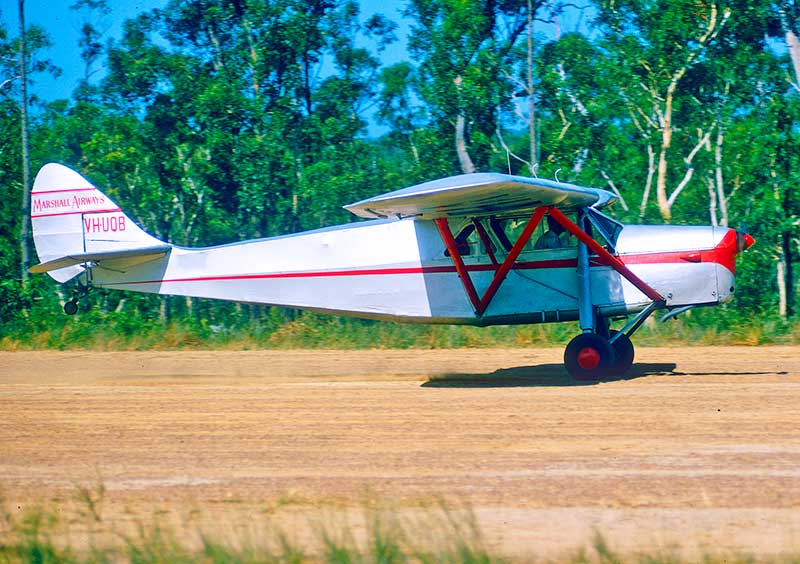
Note the additional forward strut between the front undercarriage leg attachment and the wing, an Australian
modification to improve airframe strength following a series of DH.80 structural failures around the world.
Photo by Eric Allen
The 3-seater Puss Moths were flown on early airline services by Qantas, New England Airways, North Queensland Airways and Airlines of Australia. They were also perfect for charter work and barnstorming tours by gipsy joyriders during the 1930s. However they are best remembered as the mounts of long-distance record pilots like the popular Bert Hinkler, Jimmy Broadbent and James Melrose.

De Havilland plate from Puss Moth VH-UPA. John M. Smith collection
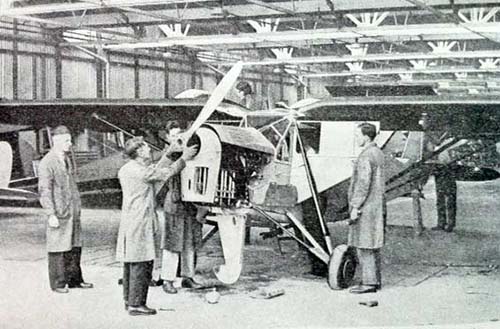
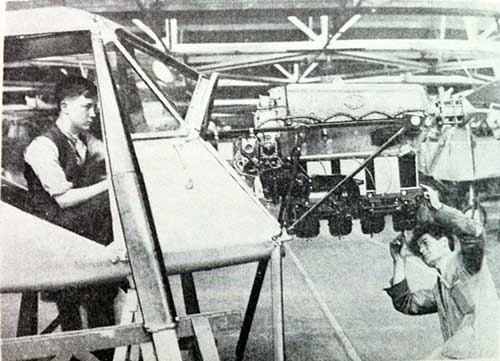
Structural failures
Puss Moth wing failures in flight around the world commenced with VH-UPC (2021) near Perth on 13 October 1930. The following year two crashed in South Africa due wings breaking away, followed quickly by similar accidents in Canada, England, France and Siam. The nation was shocked in January 1933 when Bert Hinkler went missing over the Tuscan Mountains in Italy on a record breaking attempt from England to Australia in his Puss Moth CF-APK, in which he had flown from New York to Venezuela and across the South Atlantic to Africa. When the wreck and Hinkler’s body were found three months later, there was clear evidence that a wing had broken away.
The Civil Aviation Branch first suspended the Certificate of Airworthiness for all Australian Puss Moths on 6 November 1930. H.C. Brinsmead cabled each owner "Pending investigation Puss Moth accidents, essential as a precautionary measure this machine not be flown."
A modification was promptly devised by De Havilland in England, and on certification that the modification had been completed, the suspension was lifted on 31 December 1930.
Two months later CAB again suspended all Australian CofAs effective 2 February 1931 pending a wing structure inspection. It required the wings being dismantled and fabric covering removed. Owners were advised that this suspension would be removed upon certification by a licenced ground engineer that the structure complied with requirements.
Following the fatal in-flight structural failure of VH-UPM (c/n 2052) on 18 September 1932, the CAB grounded all Australian Puss Moths five days later by cancelling their CofRs and CofAs. great concern over reported wing flutter, tailplane strength and wing design strength. Investigations into the airworthiness of the type took place in Australia, United Kingdom and by the manufacturer, concentrating on wing flutter, tailplane strength and wing structural integrity. Testing by the Royal Aircraft Establishment at Farnborough recommended a stabilising strut be fitted to the forward leg of the wing V struts, and this was one of many modifications adopted. In Australia the type remained grounded until the following year until mandatory modifications to strengthen the wing structure were finalised. When installed, each Puss Moth had its certification renewed individually.
These modification costs were born by De Havilland Aircraft Pty Ltd at Sydney, already struggling with the sales slump during the Great Depression. On 17 March 1933 the company wrote to all Australian Puss Moth owners advising them that regretfully they were no longer able to offer free service for the DH.80 type, apart from Class 1 modifications issued by their parent company in England. Then in January 1934 CAB issued a notice to all Australian DH.80 owners requiring CofA inspections and renewals every six months instead of the standard annual renewals. The notice listed specific inspections required of wing and fuselage structure at each CofA renewal.
Arthur Butler (later founder of Butler Air Transport) was making a meagre living flying VH-UPN (2023) on barnstorming joyriding tours of country towns. His book Flight written 30 years later gives a different version of the groundings:
“In May 1932 misfortune beset us when the Puss Moth was grounded for several months because some Puss Moths had fallen apart in mid-air. Within a few weeks our finances were depleted…. George Boehm, Managing Director of Genairco, who was designing a cabin biplane, offered me a job, first in the drawing office, then in the works on the prototype which I air tested as soon as it was completed. Before the end of July work came to a stop and I was again out of employment, not even a job as a labourer was available.
After I had been idle for three weeks, the embargo on the Puss Moth was lifted and we returned to joyriding in the Outback. Then ten days later another Puss Moth folded up in mid-air, which resulted in these machines being grounded again. During the six months the Puss Moth was out of commission I worked for less than five weeks. One evening in February 1933 Major Murray Jones came to our home with glad tidings. The Puss Moth had been released and would be ready to fly when certain modifications had been carried out on its wings.”
Throughout this period there had been strident criticism of the official CAB Air Accidents Investigation Committee's findings, claiming the committee lacked technical expertise to find reasons for air accidents, particularly the Puss Moth structural failures. In April 1933 a Voluntary Committee of Aeronautical Engineers called on the Federal Government for an enquiry into the administration of civil aviation in the country, stating it had submitted its own findings on the weakness of the DH.80 design only six days before VH-UPM broke up in flight. This brought a savage response from Hereward De Havilland, of the Australian De Havilland company, in a lengthy letter to the newspapers. The Minister for Defence, defending the Civil Aviation Branch, dismissed the voluntary committee's pleas and condemned their "attitude of superiority which neither the Constitution or qualifications justify."
After six years with no further airworthiness events, and only weeks after the DCA's Officer in Charge for Queensland T.L.Amos recommended to Head Office that the 6 monthly CofA inspections for Puss Moths be relaxed back to yearly, disaster struck again. On 27 August 1941 VH-UQL (c/n 2088) was destroyed near Coen, north Queensland when the port wing broke away in flight on an urgent military charter, killing the three occupants. The investigation found that the wing structure failed due to flutter.
Following extensive DCA deliberations over the future of the DH.80 in Australia, the Director General wrote to all Puss Moth owners on 21 November 1942 outlining the history of structural failures in Australia 1930-1933. "The various modifications incorporated in the structure of Puss Moth since then have not removed the root cause of the trouble. Thus the Department plans a compulsory modification of an additional strut from the front lift strut on the front spar to the attachment of the undercarriage radius rod to the lower longeron."
Surviving post-war Puss Moths in Australia feature this additional strut. The 6 monthly CofA renewals were relaxed to annual inspections effective 12 June 1944. No further structural problems were reported. Interestingly, this final modification was not required by Britain, or other countries where Puss Moths flew largely uneventful lives. The few still flying today are treasured antique aircraft.
Last word on the Australian attitude towards the Puss Moth goes to Sir Hudson Fysh, founding partner in Queensland and Northern Territory Aerial Services Ltd, which grew into Qantas Airways. Fysh recalls the Qantas Puss Moths in his autobiography Qantas Rising: “The Puss Moth during these years proved a wonderful little taxi plane and I did about 250 hours on the type, but not without later reflective misgivings, for the machine was faulty and too lightly built.”
A total of 13 Puss Moths were Australian registered, and six more fuselages were shipped here but remained unsold: see
Unassembled Australian Puss Moths at the end of the listing below.
This listing is presented in order of appearance on the Australian Civil Register:
C/n 2001 DH.80A Faith in NZ, Spirit of New Zealand VH-UON
| .29 | Built by De Havilland Aircraft Co Ltd at Stag Lane Edgeware, Middlesex. 120hp DH Gipsy III. Metal fuselage frame, replacing the wooden frame of the prototype Puss Moth. Described in DH records as "Type machine for Australia" |
| 23.12.29 | Registered G-AATC: De Havilland Aircraft Co Ltd, Stag Lane Aerodrome, Edgeware |
| 3.30 | First flight Stag Lane |
| 3.30 | British certification flight testing at RAF Martlesham Heath |
| 22.5.30 | British CofA issued |
| Shipped to Australia | |
| 8.30 | Assembled at Mascot Aerodrome, Sydney by De Havilland Aircraft Pty Ltd |
| 8.30 | Test flight Mascot by Major Herewood De Havilland |
| 7.8.30 | Australian Registration application: De Havilland Aircraft Pty Ltd, Mascot Aerodrome, Sydney NSW |
| 11.8.30 | Registered VH-UON |
| 13.8.30 | flown Mascot-Essendon by Hereward De Havilland to enable inspection by the Civil Aviation Board whch was based in Melbourne |
| 29.8.30 | Formal issue of Australian CofA |
| 26.10.30 | Change of ownership: Harry R. Clarke, Sydney NSW |
| 23.9.32 | CofR suspended by CAB for all Australian DH.80s |
| 15.3.33 | Sold by Clarke to John J. Leahy, Sydney NSW |
| 15.3.33 | Test flown at Mascot by Major Herewood De Havilland after mandatory modifications installed. Airframe total time 710 hours |
| 23.2.33 | CofR renewed: John J. Leahy, Sydney NSW |
| 2.34 | Sold by Leahy to Ray Whitehead, Sydney NSW. He was a New Zealander then living in Sydney. |
| 24.2.34 | Whitehead took delivery of VH-UON. On the same day Ray Whitehead wrote to his father living in New Zealand: "Thanks very much for sending over the money for the aeroplane of which I took delivery today. The whole of the outside is painted silver with registration letters VH-UON. It has triplex glass throughout, with brown leather upholstery. I got the Puss in a rather unusual manner, which accounts for its cheapness. A friend of mine, ex RAF, had been flying it for a wealthy station owner and was offered a job as instructor to a new flying school. When he told his employer about his new job the old fellow decided to give up flying. He wanted £550 for the machine but I offered £400 and after a fortnight he changed his mind and accepted." |
| 27.2.34 | Register Change of ownership: Raymond G. Whitehead, Club House, Mascot Aerodrome, Sydney NSW. |
| 2.34 | Whitehead commenced joyriding at Mascot |
| 3.34 | Whitehead flew UON on a charter from Sydney to Melbourne carrying a priest to visit his ill mother. Landed in a farmer's paddock at Seymour Vic due bad weather approaching Melbourne. Whitehead arranged to have a slide projected at the Seymour picture show offering joy rides, and fifty locals came out to the paddock for flights all the next day |
| 4.34 | On arrival Essendon Aerodrome, Melbourne he had a required maintenance inspection carried out. The wing fabric was opened up and later re-sewn and fabric repair doped. |
| 18.4.34 | Test flown Essendon by Whitehead after CofA renewal overhaul by Hart Aircraft Service Pty Ltd |
| 27.10.34 | Test flown at Mascot by Whitehead after CofA renewal overhaul. Total time 934 hours |
| Whitehead was joined by an Australian partner Rex Nicholl, Sydney. The name "Faith in NZ" was painted on the engine side cowling | |
| 11.34 | VH-UON was modified for a planned flight to NZ. Two passenger
seats were replaced by a large temporary fuel tank in the cabin with
plumbing to the fuel system. Both pilots would share the pilot seat. The name was repainted on the top nose cowling as "Spirit of New Zealand" |
| 14.11.34 | CofA and CofR suspended by CAB because the modifications
were not approved. CAB sent telegrams with this advice to Mascot Aerodrome and
Gerrigong Beach. CAB Groundsman at Mascot advised Head Office: "On receipt of the telegram at Mascot, Whitehead and Nichols flew to Gerrigong Beach where they intend to takeoff off for New Plymouth this evening." |
| 22.11.34 | Took off from Gerringong Beach NSW and flew to Houhora
Beach, 90 mile Beach, Doubtless Bay NZ in 14 hours 30 minutes flying
time. This was only the second crossing of Tasman Sea by a single-engined aircraft. The first was Guy Menzies on 7 January 1931 in Avro Avian G-ABCF Southern Cross Junior Next morning Whitehead and Nicholl flew on to Mangere airfield, Auckland where on landing, they were arrested by police for flying a unregistered aircraft. Summonsed to appear in court later when they were fined. Much publicity in Australian and NZ press, calling the flight a reckless stunt. |
| 11.34 | Cabin fuel tank was removed and seats replaced at Mangere with help of Auckland Aero Club and inspected for NZ CofA by RNZAF mechanics at Hobsonville. |
| 19.12.34 | VH-UON Logbook:
Registration removed. Seats removed. Reserve tank removed. Seats
replaced. Pumps removed. CofA at Hobsonville. Fabric re-doped. |
| 14.1.35 | Registered ZK-ADU Raymond G. Whitehead & Rex Nicholl, Rongotai Aerodrome, Wellington |
| Taking advantage of their press publicity, Whitehead and Nicholl flew ZK-ADU on a barnstorming tour of the NZ North Island, giving many hundreds of joyflights | |
| 18.2.35 | Logbook: arrived Wellington. Flew Wellington area until they flew to the South Island 22.3.35 |
| 7.3.35 | Logbook: "NZ Registration ZK-ADU painted on fuselage and wings", Signed R. Whitehead. This indicates that the aircraft was flown with no registration markings since 19.12.34 |
| 12.3.35 | Logbook: crossed Cook Strait to the South Island, enroute Wellington-Nelson |
| 23.3.35 | ZK-ADU noted at Stoke, silver, name on engine cowling Faith in New Zealand |
| 3.35 | Logbook: commenced 4 weeks flying in Nelson-Golden Bay area |
| 16.6.35 | Last entry in airframe Logbook: Westport-Karamea-Greymouth. |
| 10.8.36 | Change of ownership: Arthur J. Bradshaw, t/a Southland Airways, Invercargill |
| By 11.36 Ray Whitehead was flying in New Guinea for Stephens Aviation when he tipped their DH.61 Giant Moth VH-UJB Apollo on its nose landing at Madang | |
| 36 | Bradshaw did not fly this aircraft. He purchased it without CofA after it had been parked in a shed at Rongotai aerodrome, Wellington for several months. He had it shipped to Bluff then railed to Invercargill. On inspection at Invercargill it was found to have severe corrosion in the rear fuselage frame. Dismantled for spares for Bradshaw's other two Puss Moths ZK-ABG (2046) and ZK-ACX (2204) |
| Stripped airframe stored at Invercargill | |
| c42 | Bradshaw sold his two airworthy Puss Moths and the remains of ZK-ADU |
| 83 | ZK-ADU remains acquired by Colin F. Smith, Waikaka, Southland NZ At the time, Smith was restoring Puss Moth ZK-AJN. Colin Smith also acquired remains of ZK-ACX and later established a specialist vintage aircraft restoration business Croydon Aircraft Company, Mandeville |
| 98 | Owned R. Gerald Grocott, Banbury NZ. Under restoration at Mandeville by Croydon Aircraft Co |
| 02 | Restoration project advertised for sale by Gerald Grocott. |
| .03 | Fuselage frame and parts acquired by Roy Palmer, England. Shipped to England. |
| Restoration to fly by Ron Souch t/a Aero Antiques, Durley, Hampshire. | |
| 22.5.09 | Restored to British Register G-AATC Roy A. Palmer, Weybridge |
| 6.16 | Restoration to fly for Roy Palmer nearing completion.Fitted with its original large diameter main wheels. |
| 24.7.19 | First test flight Durley after rebuild, G-AATC is all silver finish |
| 14.8.21 |
G-AATC visited DH Moth Club fly-in at Bassingstroke, Hampshire |
| 11.9.21 |
G-AATC visited Shuttleworth Trust, Old Warden |
| Current |
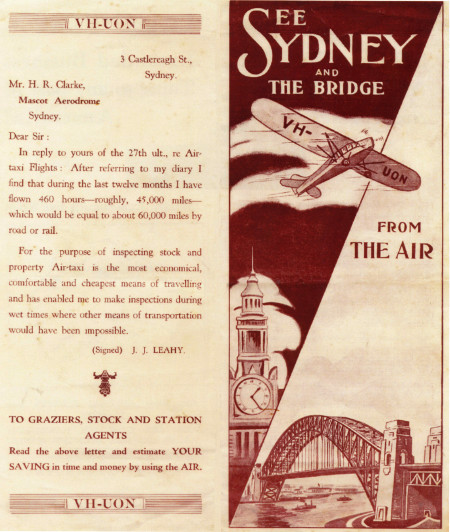
Both sides of an advertising bruchure during VH-UON's charter and joyriding days with
Messrs Clarke and Leahy 1930-34. Courtesy Civil Aviation Historical Society
Messrs Clarke and Leahy 1930-34. Courtesy Civil Aviation Historical Society


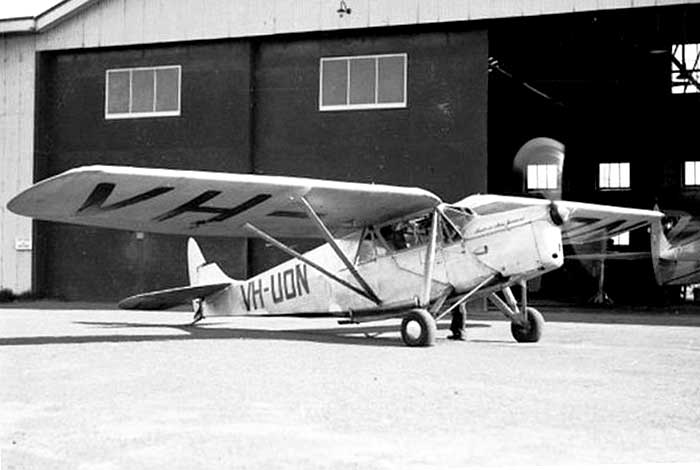
Photo: National Library of Australia
| .30 | Built by De Havilland Aircraft Co Ltd at Stag Lane Edgeware, Middlesex. 120hp DH Gipsy III |
| - | Test flown by Geoffrey De Havilland |
| .30 | Sold new to Qantas Ltd for £1118 |
| 29.7.30 | British CofA issued VH-UPA |
| Shipped to Australia | |
| 9.30 | Assembled at Mascot Aerodrome, Sydney by De Havilland Aircraft Pty Ltd, Mascot Aerodrome |
| 29.9.30 | Registered VH-UPA: Queensland and Northern Territory Aerial Services Ltd, Brisbane Qld |
| 29.9.30 | Australian CofA issued |
| 29.9.30 | Flown from Mascot to Archerfield on delivery to Qantas |
| 23.9.32 | CofR suspended due CAB grounding of DH.80 type following structural failures |
| 20.7.33 | CofR renewed after mandatory modifications completed |
| 26.11.34 | Local flight Archerfield,
checkout for pilot Bert Hussey who had just been employed by QEA,
previously with MMA in Perth. Hussy made another local flight in VH-UPA
the next day |
| 20.1.35 | Pilot logbook H.B.Hussey: Brisbane-Bundaberg return |
| 4.3.35 | Pilot logbook H.B.Hussey: Brisbane-Cracow-Brisbane (between flying QEA DH.61s and DH.86s) |
| 15.6.37 | Change of ownership: North Queensland Airways Pty Ltd, Cairns Qld. Managing Director Thomas H. McDonald. |
| 30.4.38 | Damaged in forced landing between Townsville and Cairns |
| 25.10.38 | North Queensland Airways routes and assets taken over by Airlines of Australia Ltd, Sydney |
| 19.12.38 | Register Change of ownership: Airlines of Australia Ltd, Sydney |
| 25.1.39 | CofA renewed after rebuild |
| 9.6.39 | Gipsy III engine ex VH-UPA sold by Airlines of Australia to
College of Civil Aviation, Mascot Aerodrome, who fitted it to Genairco VH-UOD. |
| 2.8.39 | Change of ownership: Roy L. Beresford, "Farnham Plains" Station, Eulo Qld and Cunamulla Qld |
| 45 | VH-UPA was tied down outside at Mascot pending maintenance by Marshall Airways |
| 18.7.45 | Change of ownership: Horace Hayes, Bega NSW |
| 31.7.45 | CofA renewed at Mascot by Marshall Airways |
| 29.9.45 | Logbook: Towed with wings folded from Mascot to Bega NSW, where stored |
| 13.1.46 | Test flown at Bega after brought out of storage. Ferried to Mascot for CofA inspection by Marshall Airways, remained with Marshall Airways until 6.46 |
| 4.6.46 | Change of ownership: Guy K. Bolton, t/a Cairns Flying
Service, Cairns Qld. Sid Marshall acted as agent to sell Hayes' Puss Moth VH-UPA and D.H.60 Moth VH-UAE to Bolton. |
| 6.46 | Ferried from Sydney to Cairns by Cairns Flying Service chief pilot Charles Gatenby |
| 25.7.47 | Sold to Australian Air Traders Pty Ltd, 12 O'Connell Street, Sydney AAT was the parent company of Guinea Air Traders. AAT purchased all Cairns Flying Service aircraft on this date in order to acquire their two Avro Ansons to add to the large Guinea Air Traders Anson fleet based at Lae, New Guinea. Aircraft included in the sale were: DH.80 VH-UPA, DH.60 VH-UAE, DH.82s VH-APZ & VH-AQQ, Avro Ansons VH-BBC & W1587. |
| 8-9.47 | All six CFS aircraft were ferried from Cairns to Sydney during August & September 1947 |
| 19.11.47 | VH-UPA CofA renewed at Mascot |
| 11.47 | Australian Air Traders, Sydney advertised the DH.60, DH.80 and DH.82s acquired from CFS for sale in Aircraft magazine. All described as being in excellent condition. |
| 8.10.48 | Change of ownership: Methodist Inland Mission, Camooweal Qld, later Alice Springs NT, c/- Reverend P. A. Lyons. The mission traded their DH.83 Fox Moth VH-ABU to Australian Air Traders on the Puss Moth. |
| 10.48 | MIM wrote to DCA: "We are known throughout the inland by the letters ABU" and requesting the registration be transferred to the Puss Moth |
| 11.10.48 | Re-registered VH-ABU. Named T. C. Rentoul, the long-time Director of the Methodist Inland Mission |
| 20.10.48 | Logbook: repainted as VH-ABU during overhaul at Camden NSW. CofA renewed Camden 20.1.49. |
| 5.49 | Ferried from Camooweal to Alice Springs via Mount Isa by Rev. P. A. Lyons. Now based Alice Springs |
| 11.49 | Withdrawn from service at Alice Springs. Rev. P. A. Lyons wrote to DCA from Alice Springs: "The nature of our work here is being dispensed with and the aircraft is up for sale." |
| 17.5.50 | Change of ownership: Charles D. Pratt, 86 McCracken Street, Essendon, Melbourne Vic Purchase price £175 |
| 21.6.50 | Arrived Essendon on delivery flight from Alice Springs via Adelaide by Charlie Pratt |
| 17.8.50 | Annual CofA renewal at Essendon |
| Letter to Flightpath magazine August 2009 from Jim Darbyshire, Griffith NSW: "Re Puss Moth VH-ABU. This aircraft in the early Fifties was owned by Charlie Pratt who was an interesting character. He was a fighter pilot in World War One, later operated a flying school at Geelong before joining Australian National Airways. After his retirement he operated the Puss Moth on joyriding and aerial photography. Graham Hewitt and I, both copilots on DC-3 aircraft with Ansett Airlines, in turn flew ABU on joyriding and aerial photography. Charlie would sell the tickets and load the passengers. On photo work he would dangle out the left hand rear window hanging on to a large old Fairchild camera. He guided us with jabs in the back from his right hand elbow." | |
| 23.7.51 | Change of owner's name: C.D. & L.F. Pratt Pty Ltd, 86 McCracken Street, Essendon Vic |
| 14.8.53 CofA renewed at Essendon by Ansett Airways | |
| 28.3.54 Logbook: airframe time 3,969 hours 10 mins | |
| 16.9.54 CofA renewed at Moorabbin by Air Operations Pty Ltd | |
| 25.11.55 CofA renewed at Moorabbin by Schutt Aircraft Pty Ltd | |
| 57 | Charlie Pratt was having increasing ATC restrictions operating from Essendon Airport because VH-ABU was not fitted with radio |
| 27.10.57 | Logbook: last flight, local flight from Essendon |
| 20.11.57 | CofA expired |
| 57 | CofA renewal inspection commenced at Essendon by Southern Airlines, who flew Herons and Doves to Victorian, SA & NSW towns |
| 26.8.58 | C.D. Pratt wrote to DCA advising that VH-ABU has not flown for the past 12 months due to legal action between himself and Southern Airlines |
| 1.11.58 | Southern Airlines ceased operations, laying off its staff. The fuselage had been completed but the wing fabric was removed for recovering and the overhaul paperwork had not been completed. Pratt could not afford to have the job started again, and left the aircraft in a hangar at Essendon. |
| c59 | Sold by Charlie Pratt for a small sum to Mr. Roly McKenzie, Thomastown, Melbourne who took it by road to his house at 11 Traverse Street the Melbourne suburb of Thomastown. McKenzie built a back yard shed to house the DH.80 which was chocked up with its wheels off the ground and wings stacked alongside. |
| 7.61 | Struck-off Register as Withdrawn from Service effective 15.9.58 |
| 19.6.63 | Letter to DCA from Mr. R. McKenzie: "I have an interest in VH-ABU which was bought from Mr. Pratt. It last flew in 1957. We propose to get this aircraft flying again and rebuild the wing structure." |
| 1.9.64 | Letter to DCA from Robin J. Nuttall, Edenhope Vic: "I am negotiating to
purchase VH-ABU to restore to airworthy condition. I plan to design an
entirely new wing structure." In 10.64 Nuttall purchased an airworthy Ryan STM VH-AGW instead |
| 65 | Remained with McKenzie stored under cover in the shed in his backyard |
| .65 | Purchased by E. Robert Burnett-Read, Adelaide. Bob Burnett-Read was President of Vintage Aircraft Club of Australia, and had owned Ryan STM VH-AGW, BA Swallow VH-UUM, Comper Swift VH-ACG and Percival Proctors VH-GGB & VH-SCC, all based at Parafield |
| 11.65 | Collected for Burnett-Read by members of the West Beach Aviation Group,
Adelaide. A large glider trailer was towed by road from Adelaide to Melbourne behind Geoff Goodall's Ford Zephyr
sedan. VH-ABU was loaded on to the trailer at Thomastown
and towed back to Adelaide The party comprised John Smith, Brenton Holt, Arthur Perkins and
Geoff Goodall. |
| 66 | Stored behind Bob Burnett-Read's house in North Adelaide pending
planned restoration to fly. Also stored at this house were Mraz Sokol VH-BXY and BA Swallow VH-UUM, both which had been retired at Parafield |
| 3.67 | Burnett-Read was forced to move the remaining aircraft from
the house at North Adelaide. Swallow and Puss Moth were towed on their
wheels by WBAG members to Consignment Motors, 641 Marion Road, Plympton
by Geoff Goodall's Ford Zephyr. They were parked behind a shed at the
rear of the car yard, with wings stacked nearby. The car yard arrangement was only temporary and both aircraft had to be moved again. The Swallow was towed to Salisbury to be stored by aircraft enthusiast John Boden. WBAG member John Smith volunteered the back garden of his Brighton home for the Puss Moth. |
| 6.67 | VH-ABU moved from the car yard to John Smith's house at 416 Brighton
Road by WBAG members John Smith, Mike Vincent, Melv Davis and Trevor
Smith, towed behind Geoff Goodall's Ford Zephyr. Over following weeks the wings were attached to the fuselage standing on its wheels for photographs in the back garden. |
| .69 | John Smith's house was sold for commercial redevelopment.
Burnett-Read had arranged for the Puss Moth to be moved to the Birdwood
Mill Museum which had several aviation exhibits. But a communications lapse resulted in
VH-ABU still in the back garden when the house was being
demolished. Local schoolboy Kim Kader, Brighton SA, aged 14, was told by the demolition foreman that the aircraft would be destroyed and offered it to Kim for $10. |
| .69 | Towed on its wheels to Yarmouth Street, South Brighton where it left among fruit trees on a block next to the home of a friend. Photographed there 14.2.70. |
| By the time the Birdwood Mill Museum volunteers arrived at the Smith address to collect the aircraft, the house had been demolished and the Puss Moth was gone. Burnett-Read assumed it had been carted away for scrap. | |
| .70 | Advertised for sale in The Advertiser newspaper by Kim Kader:
"Aeroplane. Vintage D.H. Puss Moth 2 seater suit keen restorer, $45 as is" Within days of the advertisement, Robert Stewart, Waikerie SA phoned and purchased the aircraft on behalf of a syndicate of four pilots, who took it to Waikerie by road on a trailer where it was kept for about a year in the Schneider Gliders hangar. Syndicate members were Robert G. Stewart, Bob Pratt, Bruce Hartwig, David Schenke, using the name Thorpe Aircraft Australia, Waikerie. They had a workshop where they were building a Thorpe T-18 and an EAA Biplane. Neither was finished but the Thorpe was sold to NSW and eventually completed. Bob Pratt recalls in an Email 12.3.2010: "As far as I recall the aircraft was complete less engine prop and instruments. The wings being wooden were almost decayed to nothing but the fuselage fabric was still in reasonable condition and I remember cutting out the rego and putting it on the wall of our workshop at Waikerie Aerodrome. I did some restoration work in the cabin and remember getting the drag struts to function. We paid $60 for the aircraft and sold it for $600. Big profit in those days!!" |
| 10.5.70 | VH-ABU noted dismantled in hangar at Waikerie SA. Fabric removed on fuselage, wings in the rafters. |
| .71 | Waikerie syndicate sold ABU to Chris Battye, Adelaide, who changed his name to Chris Lindisfarn. He was a young aircraft engineer based at Parafield |
| 6.2.71 | VH-ABU noted dismantled in glider hangar at Gawler airfield SA |
| - | Reportedly acquired by Barry Bell, Adelaide who owned Tiger Moth VH-DDA |
| c72 | Acquired by Jim O’Connell, Adelaide, later Melbourne. He was also an aircraft engineer with an interest in vintage aircraft. When he moved to Melbourne to take up a LAME job with Forrester Stephen Aviation at Essendon Airport, he had VH-ABU’s remains moved by road to Melbourne. |
| 72-73 | Stored in shed at Jim O’Connell’s mother’s house in Melbourne suburb of Camberwell. When the house was sold, O’Connell had to dispose of VH-ABU’s remains, to concentrate on the restoration of his DH.84 Dragon VH-AGC |
| .73 | Purchased as a restoration project by Clive H. Phillips, Heidelberg, Melbourne. Moved to Clive Phillips’ workshop in Melbourne suburb of Heidelberg. Clive recalls “It was a huge job to restore due to its total deterioration. Luckily John Petit later bought it and progressed the restoration” |
| 81 | Report: held by Melbourne vintage aircraft enthusiast Clive Phillips who is collecting components for its rebuild to fly. He has a complete rudder acquired in England. |
| 31.7.82 | Registration VH-UPA reserved for C. H. Phillips |
| .84 | Project purchased by John Pettit, "Wooloomanata" Station near Avalon Vic
who commenced a long-term restoration to fly, in a hangar at his farm
property "Wooloomanata" which had been used as a satellite airfield
during WWII. The Puss Moth wings were sent to NZ for restoration by woodwork specialists Croydon Aircraft Company at Mandeville. After 8 years of restoration, the wings were returned to Pettit without fabric covering. |
| 2.99 | VH-UPA was a static display at Avalon International Airshow as part of a
Qantas historic feature. Fuselage framework was restored but not fabric covered, standing on its own wheels. Wings were attached and folded back, having been restored by Croydon Aircraft Company in NZ, who also had restored the fuselage floor. |
| 27.10.01 | noted at John Pettit's property "Wooloomanata", as an ongoing restoration. Also there were Pettit's DH.87 Hornet Moths VH-UTE airworthy and VH-ABO under restoration, Tiger Moth VH-PSD and Auster AOP-9 VH-XKA |
| .08 | Acquired partially restored from Pettit by Lex Rowland for the Hinkler Museum and restoration for static display completed at workshop of Ian Watson. |
| 12.08 | Displayed suspended from the roof inside at Hinkler Hall of Aviation, Bundaberg Qld This new museum was opened 7.12.08 and incorporates the Hinkler House Memorial Museum. Painted as CF-APK with name Karohi, to represent the Puss Moth in which Hinkler was killed on 7.1.33 in the French Alps on a record attempt from England to Australia. The Australian additional wing strut modification has not been included to add to authenticity. |
| Current |
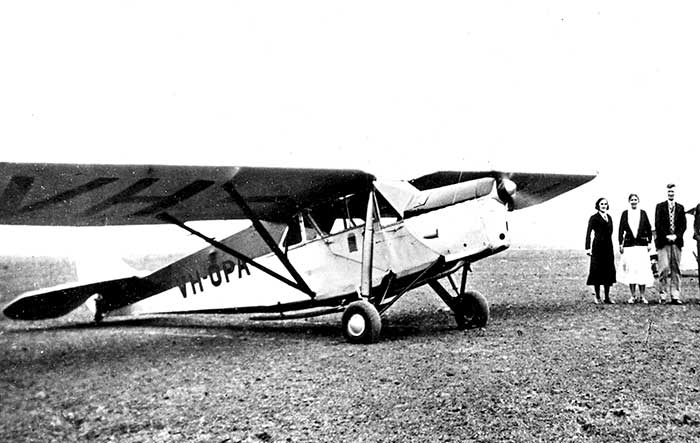

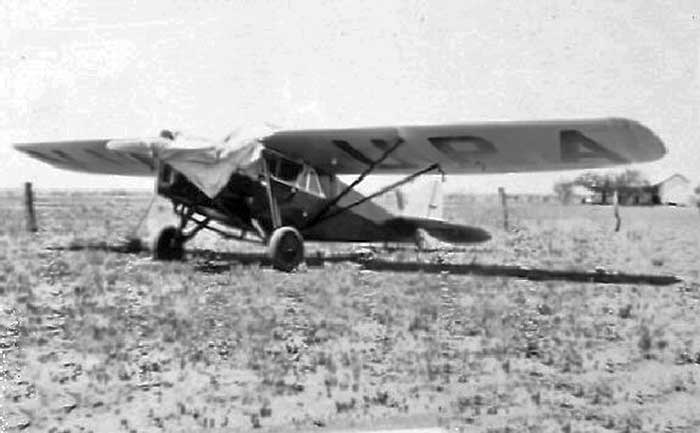
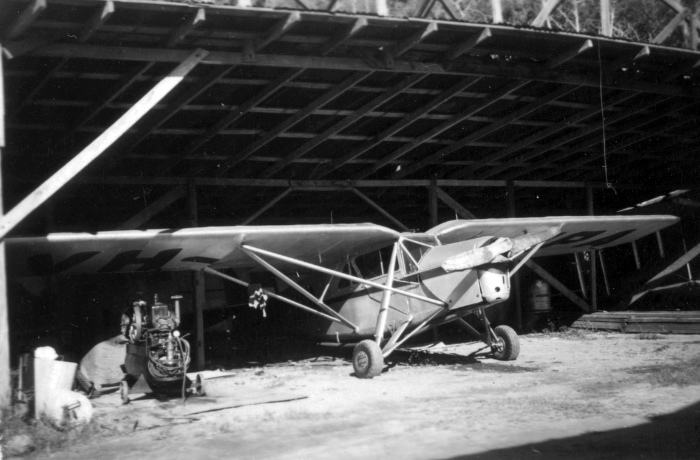
Undated picture of VH-UPA at Cairns airfield, either prewar with Airlines of Australia or 1946 with Cairns Flying Service.
Civil Aviation Historical Society Allan Betteridge collection
Civil Aviation Historical Society Allan Betteridge collection
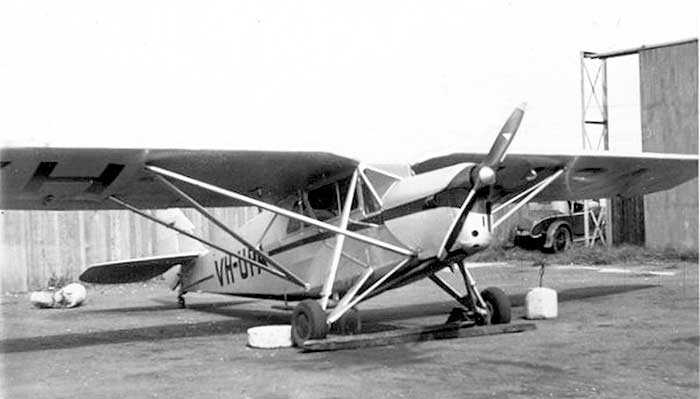
.jpg)
Now re-registered VH-ABU, at Alice Springs June 1950 being refuelled by Charles Pratt prior to the ferry to Melbourne.
Painted on the nose is "Methodist Inland Mission" and the name "T.C. Rentoul".
Photo by Charles D. Pratt, courtesy Kevin O'Reilly
Painted on the nose is "Methodist Inland Mission" and the name "T.C. Rentoul".
Photo by Charles D. Pratt, courtesy Kevin O'Reilly
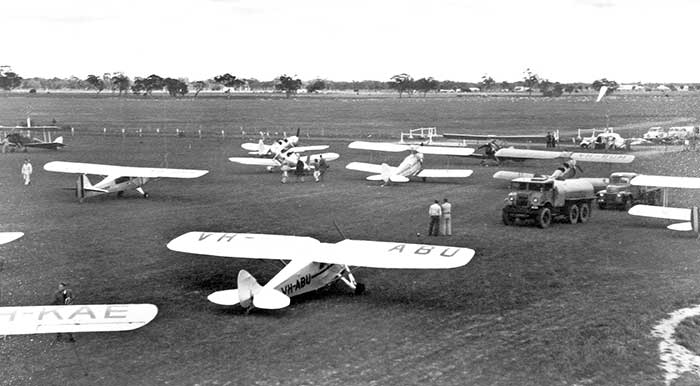
VH-ABU
visiting a 1950s airshow at Horsham Vic.
Photo: Charles D. Pratt
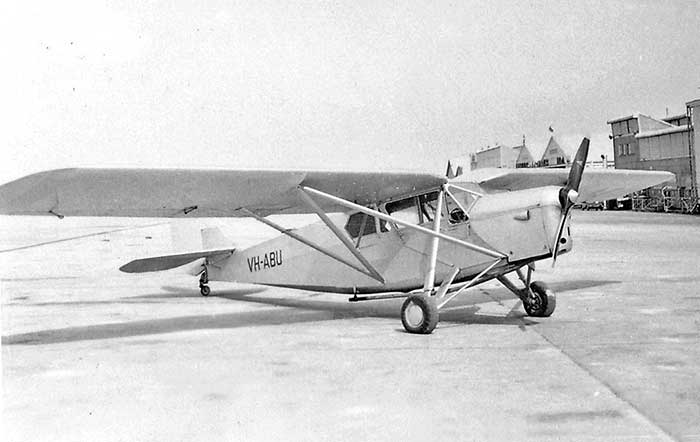

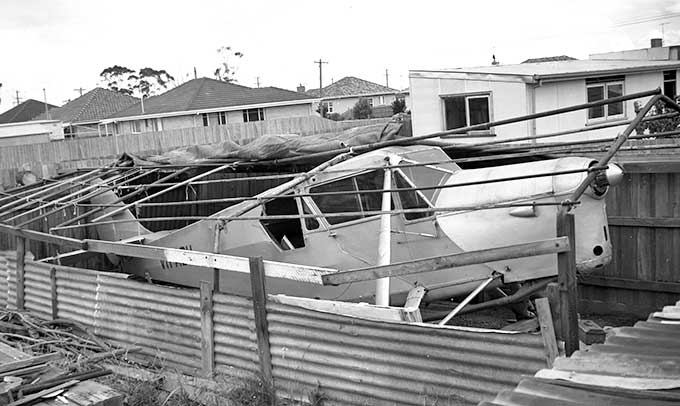
Photo by Geoff Goodall
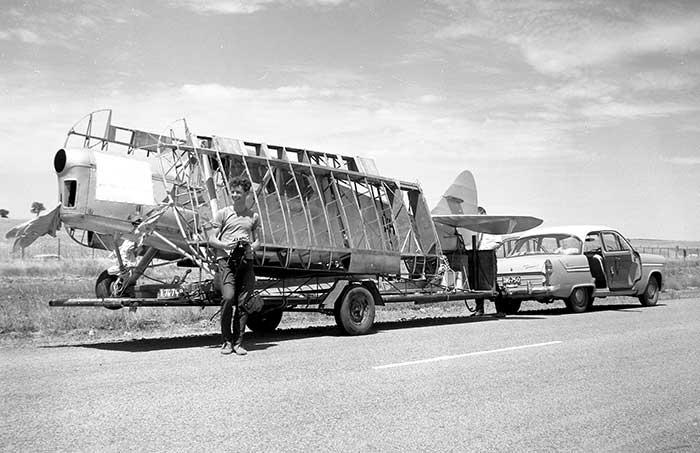
VH-ABU
on the road from Melbourne to Adelaide, November
1965.
Photo by Geoff Goodall
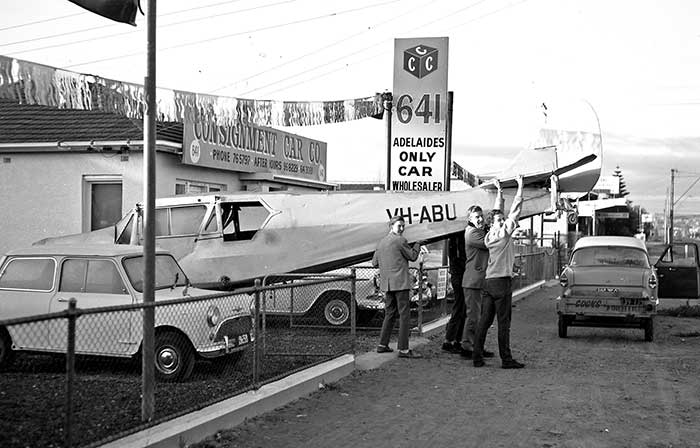
Photo by Geoff Goodall

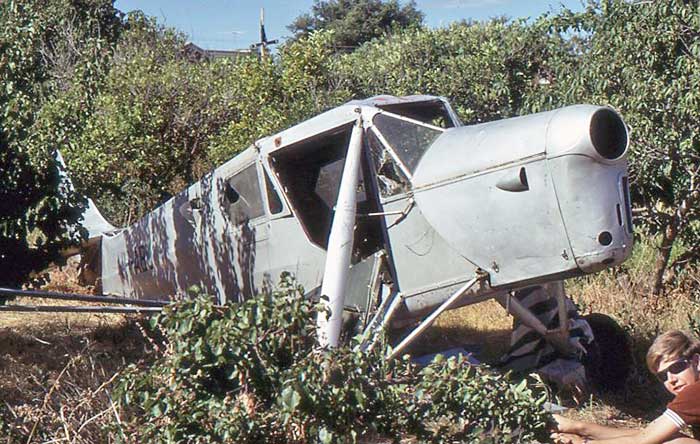
Photo by Nigel Daw, with his brother Paul helpfully holding down the bush in the foreground.
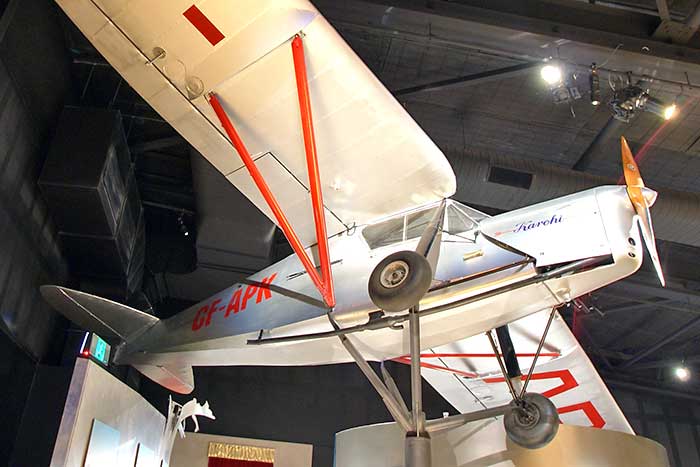
| .30 | Built by De Havilland Aircraft Co Ltd at Stag Lane Edgeware, Middlesex. 120hp DH Gipsy III |
| 29.7.30 First flight Stag Lane | |
| 30.7.30 British CofA issued De Havilland Aircraft Pty Ltd, Sydney NSW | |
| .30 | Sold by De Havilland Aircraft Pty Ltd, Sydney to Wings Ltd, Perth for £1300 |
| 8.30 | Western Air Services, Perth WA changed its name to Wings Limited, retaining the same directors and the same two pilots Charles H. F. Nesbit (Managing Director) and Charles W. Snook. Nesbitt had previously flown for West Australian Airways. The announcement of the name change stated that Wings Ltd were now agents for a range of aviation products including De Havilland aeroplanes and that a DH.80 Puss Moth had been ordered |
| Shipped to Australia | |
| 17.9.30 | Unloaded from boat at Fremantle and taken by road to Maylands Aerodrome same day. Assembled at Maylands by Wings Ltd |
| 25.9.30 | Test flown at Maylands after assembly |
| 28.9.30 | Named Fleetwing in a ceremony at Maylands aerodrome. |
| 7.10.30 | Registered VH-UPC: Wings Ltd, Perth WA c/- Mr. Charles H.F.Nesbit |
| 7.10.30 | Australian CofA issued |
| 12.10.30 | VH-UPC participated in flying displays at an airshow at Maylands, flown by Charles Snook. Wings Ltd reported that it conducted profitable joyriding at the event. |
| 13.10.30 | Crashed near Chidlow Wells WA due structural failure of starboard wing. Crash site was in the Darling Ranges, 30 miles east of Perth WA. The aircraft was returning to Maylands from a cross country navigation training flight. Pilot Captain Charles Nesbit and two trainee pilots William Bell and Miss Heidie Rae were all killed. |
| Investigation found that the starboard wing had separated from the airframe, caused by failure of the main spar at the root of the wing. A large section of the starboard aileron was found a half a mile from the rest of the wreck. | |
| 23.10.30 | Struck-off Register |
| 26.3.31 | A writ was taken out in the Supreme Court of WA by Wings Ltd against De Havilland Aircraft Pty Ltd, Sydney claiming damages of £1,040 due breach of warranty. This was the first time such legal action had been taken in Australia in regard to an aircraft. No record of outcome. |
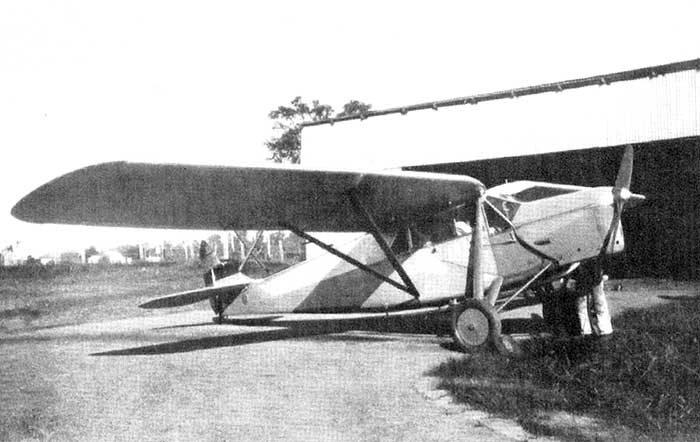
| .30 | Built by De Havilland Aircraft Co Ltd at Stag Lane Edgeware, Middlesex. 120hp DH Gipsy III |
| 22.8.30 | First flight |
| 26.8.30 | British CofA issued: Matthews Aviation Co, Melbourne Vic |
| Shipped to Australia | |
| 10.30 | Assembled at Essendon Aerodrome, Melbourne by Matthews Aviation |
| 27.10.30 | Test flown Essendon after assembly |
| 30.10.30 | Registered VH-UPJ: Matthews Aviation Pty Ltd, Essendon Aerodrome, Melbourne Vic |
| 1.12.30 | CofA issued |
| 1.12.30 | Change of ownership: Thomas Peter Manifold, "Wiridgil", Camperdown Vic |
| 31 | Based at Essendon, Peter Manifold is associated with Matthews Aviation |
| 32 | Flown in central Australia in support of Lasseter's Central Australian Gold Exploration expedition, along with with DH.75 VH-UNW |
| 9.7.32 | Test flown at Mascot by Hereward De Havilland after overhaul to renew CofA. Airframe time 134 hours |
| 12.7.32 | Change of ownership: Mrs Jessie Grace De Havilland, Sydney NSW This was part of a deal negotiated by Major Hereward De Havilland, founder of the Australian DH company, to complete and sell one their stored DH.80A fuselages. Manifold would trade in VH-UPJ which Hereward and his wife would purchase for their personal use. His wife, previously Mrs. Jessie Ware of Melbourne, had learnt to fly. |
| 23.9.32 | CofA suspended by CAB in type grounding due accidents |
| 16.3.33 | Test flown Mascot by Hereward De Havilland after mandatory modifications. Airframe time 186 hours. CAB approval received to return to service |
| 30.9.33 | Test flown Mascot by Hereward De Havilland after CofA renewal. Airframe time 213 hrs |
| 10.33 | Departed Sydney as freight on board MV Shirala for Colombo, Ceylon. Owner was moving to England. |
| 10.33 | Unloaded at Colombo, assembled and flown by Hereward De Havilland and his wife to India |
| 30.11.33 | Departed Calcutta bound for England. Delayed at Konia, Turkey for 4 days due weather, then held up at Eskishehr, Turkey for 10 days due Hereward’s ill health |
| 16.1.34 | Arrived Constantinople, Turkey |
| 1.34 | Mr & Mrs De Havilland left the Puss Moth at Bucharest and continued to London overland. They reached London by train on 14.2.34 |
| 7.5.34 | Registered G-ACSB: Mrs Jessie G. De Havilland, Hatfield |
| 16.5.34 | British CofA issued |
| 10.34 | Flown on trials by DH as part of wing stiffness tests |
| 1.3.35 | Registered PH-AMN: A. M. Noordenbos, Twente, Netherlands |
| 20.12.35 | Change of ownership: A. L. Bauling, Twente |
| 5.40 | Assumed destroyed during german invasion of Holland |
| 20.12.41 | Registration lapsed |

C.D.Pratt collection photographs are courtesy Kevin O'Reilly

Puss Moth VH-UPJ and Hawk Moth VH-UNW in central Australia while supporting a 1932 expedition searching for
the fabled outback Lasseters's Gold Reef Ed Coates Collection
the fabled outback Lasseters's Gold Reef Ed Coates Collection
| .30 | Built by De Havilland Aircraft Co Ltd at Stag Lane Edgeware, Middlesex. 120hp DH Gipsy III |
| 25.8.30 | First flight Stag Lane |
| 27.8.30 | British CofA issued: Q.A.N.T.A.S Ltd, Brisbane Qld |
| Shipped to Brisbane on S.S. Port Adelaide | |
| Sold by Qantas prior to assembly to New England Airways c/- New England Motor Co, Lismore NSW | |
| Assembed by Qantas Ltd at Archerfield Aerodrome, Brisbane Qld | |
| 24.10.30 | Test flown after assembly Archerfield |
| 31.10.30 | Qantas cable CAB for permission for VH-UPM to be flown on delivery to New England Airways prior to certificates issued. |
| 4.11.30 | Australian registration application: New England Airways, Lismore NSW. Form signed by airline founder G. A. Robinson |
| 7.11.30 | H.C.Brinsmead, Controller of Civil Aviation cables a reply: "Pending investigation Puss Moth accidents, essential as a precautionary measure this machine not be flown." |
| 20.12.30 | Qantas certify to CAB that mandatory DH.80 modification has been completed on: VH-UPM now owned New England Airways VH-UPO now owned Robert Reid VH-UPA & VH-UPQ owned Qantas Ltd |
| 20.12.30 | Registered VH-UPM New England Airways Ltd, Lismore NSW. Named Miss Lismore |
| 20.12.30 | Australian CofA issued |
| 1.3.31 | VH-UPM and Ryan VH-UIZ operated New England Airways' inaugural passenger service Lismore-Brisbane-Lismore |
| 17.3.31 | VH-UPM operated New England Airways' inaugural passenger service Lismore-Sydney |
| 17.7.31 | VH-UPM flew inaugural service of New England Airways' extended service Lismore-Sydney, pilot R. Robinson |
| 27.11.31 | Test flown at Mascot by Reg Robinson after CofA renewal overhaul. Total airframe time: 652 hours |
| New England Airways senior pilot Keith Virtue refers to his brother Ralph in the book Virtue In Flying: “The New England Airways hangars at Mascot, Archerfield and Lismore were alive with activity. Jason Hassard and Ralph Virtue were as busy with the smaller aircraft as the then more experienced pilots with the Avro Tens. Ralph now had his Commercial Licence and about 300 hours up and was doing a number of charter flights with the Puss Moth “Miss Lismore”. | |
| 24.3.32 | Forced landing at Tuncurry Beach NSW due engine trouble |
| 31.8.32 | Forced landing Mascot due engine trouble, no damage. Pilot Ralph Virtue, 2 passengers |
| 18.9.32 | Crashed near Byron Bay NSW due structural failure. Wing failed in flight while flying low over mountain ranges to stay below cloud cover, crashed on a hillside inland from Byron Bay. Pilot Ralph Virtue, Captain Les Holden and Dr. George R. Hamilton all killed |
| The book Virtue In Flying quotes NEAW senior pilot Keith Virtue: “At this time, Captain Les Holden, one of the Adelaide Holden transport family, and famous as a WWI air ace as well as for his rescue of Kingsford Smith and Ulm in the Kimberleys in 1929, arrived in Australia from New Guinea on a combined business and holiday trip. In New Guinea he had established an air transport service from Salamaua on the coast to the goldfields at Wau, and this venture was so successful he needed to buy extra aircraft. Captain Holden, his wife and three young daughters flew by New England Airways from Brisbane to Sydney. Where they spent time with his great friend, Dr.George Hamilton, a Macquarie Street skin specialist who had accompanied him on the Kimberleys rescue trip as well as countless other occasions. The two men had arranged with Brisbane friends to take a holiday cruise along the Barrier Reef in their yacht, and decided to charter a new England Airways Puss Moth to take them up to Brisbane. Ralph Virtue was the pilot. They set off from Sydney on Sunday morning 18 September 1932 with fishing gear, rolls of camera film, luggage and a small mail bag, well under the maximum load. They arrived at Lismore at 1.30pm to refuel and took off heading coastwards because in the overcast weather with south-easterly squalls a direct flight over the McPherson Ranges was impractical. To reach the coastal route however, there was still Coorabell Ridge, a 700 feet spur of the Burringbar Range to negotiate. The plane was caught in a sudden downdraught and turbulence as it flew over the ridge at about 100 feet to keep under the cloud. According to a half dozen eye witnesses it appeared to turn a somersault in the air, the pilot managed to right it, then the left wing broke off and the rudder. It dived sideways, crashed with tremendous force, buried itself in the ground and shot forward again, splintering to pieces.” | |
| 23.9.32 | Struck-off Register |
| 27.2.33 | New England Airways agreed to a request from the British Air Ministry for the wrecked airframe to be shipped to UK for detailed inspection. |
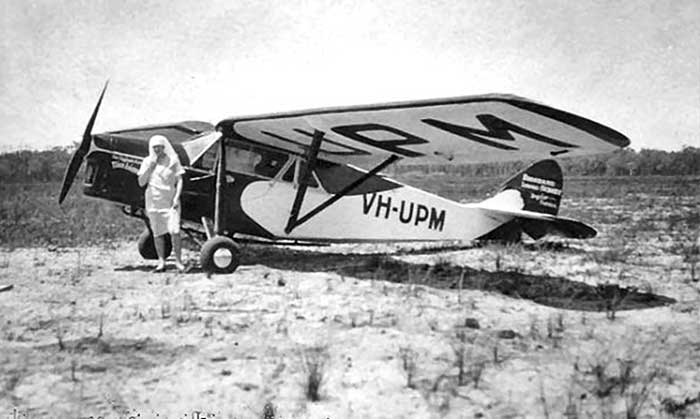
Coffs Harbour NSW, "Miss Lismore"
on nose cowling.
Photo: Coffs
Harbour Regional Museum

| .30 | Built by De Havilland Aircraft Co Ltd at Stag Lane Edgeware, Middlesex. 120hp DH Gipsy III |
| 6.9.30 | First flight Stag Lane, by DH test pilot Captain Hubert Broad |
| 10.9.30 | British CofA issued: De Havilland Aircraft Pty Ltd, Sydney NSW |
| Shipped to Australia | |
| Assembled at Mascot Aerodrome, Sydney by De Havilland Aircraft Pty Ltd | |
| 11.11.30 | Registered VH-UPN: De Havilland Aircraft Pty Ltd, Mascot Aerodrome, Sydney NSW |
| 13.11.30 | Test flown Mascot after assembly by Major Herewood De Havilland, Managing Director |
| 14.11.30 | CAB approves aircraft to be flown pending formal issue of certificates |
| 21.11.30 | Australian CofA issued |
| Demonstrator, "De Havilland Puss Moth" painted on nose cowlings | |
| 2.31 | CofA suspended by CAB,
suspension will be removed upon certification by a licenced ground
engineer that the required wing structure inspection had been carried
out. VH-UPN commenced flying again 7.3.31 |
| 4.4.31 | Badly damaged on landing at Gerringong Beach NSW on a charter flight.
Starboard wheel struck soft sand and the aircraft swung violently, distorting the fuselage, damaging the port undercarriage and wing spars. Pilot Herewood De Havilland |
| 8.5.31 | CAB Inspection report at Mascot after rebuild. Airframe total time 109 hours |
| 23.11.31 | CAB Inspection report at Mascot after CofA renewal overhaul. Airframe total time 287 hours |
| Several modification kits from DH in England installed. CAB reduces the maximum payload pending a review of these mods. | |
| 32 | Early 32 loaned to C. Arthur Butler, Sydney NSW by De Havilland
Aircraft to operate on joyriding while promoting the aircraft type. Butler was an experienced pilot and engineer, at that time popular with the public because of publicity for his solo flight from England in Comper Swift G-ABRE in November 1931 followed by an Australian demonstration tour. He had previously been making a living from country joyriding country tours in his Avro Avian. |
| Butler used VH-UPN for joyriding. He later wrote in his book Flight: “The Depression had reduced many to penury and the government’s Savings Bank by closing its doors left us so near destitution that we would have been on the dole had not Major Murray Jones, Managing Director of de Havilland’s given me the chance of barnstorming with a Puss Moth. Our earnings were scanty but we managed to make a living thanks to the sales ability of my wife who persuaded the public to fly during our working honeymoon which was spent visiting many centres in the north west of NSW.” | |
| 8.5.32 | Forced landing Mascot after engine failure on takeoff, no damage, pilot C.A.Butler |
| 23.9.32 | CofR of all DH.80s suspended by CAB pending wing structure modifications |
| 16.12.32 | Inspection report at Mascot after wings opened up for CAB inspection: some rib attachment points were found to be u/s |
| 2.33 | Butler wrote: “One evening in February 1933 Major Murray Jones came to our home with glad tidings. The Puss Moth had been released and would be ready to fly when certain modifications had been carried out on its wings. The major said his company had decided to discontinue joyriding but would sell the aircraft to me on my own terms, a generous offer. With insufficient money to pay next month’s rent for the roof over our heads, the only way for me to buy the Puss Moth was to earn the money first. The Major agreed that the aircraft be paid for at the rate of £10 per week, no deposit and no interest. I warned that in the event of an accident they may well wait years for their money because I could not afford to insure the aircraft.” |
| 16.2.33 | Test flown Mascot after mandatory wing modifications. Airframe total time 571 hours |
| 17.2.33 | CofR renewed |
| 2.33 | Arthur Butler resumed joyriding in western NSW, often sleeping under the wing of the aircraft. He was paid a weekly fee to have the advertising Heenzo cures colds painted under the wings. |
| 2.5.33 | Official Change of ownership: C. Arthur Butler, Sydney NSW, later Cootamundra NSW. |
| 6.33 | Due to the southern winter, Butler moved north, joyriding at Brisbane at the end of June. Then through western Queensland to Mount Isa where he took up a total of 232 passengers |
| 7.33 | Butler returned to Sydney from Queensland, with enough funds to pay for an overhaul |
| 29.8.33 | Test flown at Mascot by Butler after a CAB inspection |
| 28.10.33 | Butler returned to the landing ground at Ayr Qld due engine problem. |
| 30.1.34 | Flown Sydney-Melbourne by Butler, to submit
his tender for a scheduled airmail service on the
Cootamundra-Charleville sector of the new Empire Air Mail. (He was successful and his newly formed company Butler Air Transport commenced the route with DH.84 Dragons on 10 December 1934) |
| 2.2.34 | Butler departed Essendon on an urgent charter flight to Sydney, encountered severe weather enroute |
| 24.2.34 | Test flown at Mascot by Butler after overhaul. Airframe total time 1,032 hours |
| 2.9.34 | Test flown at Cootamundra NSW by Butler after CofA renewal overhaul |
| 7.35 | Sold to Robert C. Godsall, Sydney NSW. Named Skylark. Register ownership change was dated 14.8.35 |
| 24.7.35 | VH-UPN reported low flying over Mittagong NSW, pilot R.C.Godsall, again 31.7.35 |
| 2.1.36 | VH-UPN reported low flying over Palm Beach NSW, pilot R.C.Godsall's pilot licence suspended for 28 days by CAB |
| 29.2.36 | Forced landing Uralla NSW due engine trouble, no damage. pilot Godsall |
| 28.6.36 | Forced landing on canal bank on western boundary of Mascot Aerodrome, Sydney due engine failure, no damage. Pilot Godsall |
| 6.36 | CAB letter to Godsall regarding reports that two different radio sets with a morse code key had been installed in UPN without authorisation, expressing concern over the electrical wiring. Goodsall does not reply and for next two years CAB attempts to prove that radios are being fitted whenever Godsall flies UPN away from Sydney. A CAB memo "Mr. Godsall appears to be a little difficult to impress regarding airworthiness matters." |
| 5.9.36 | Goodsall few a display and gave joyrides at an airshow at Cessnock NSW |
| 6.11.36 | Goodsall flew VH-UPN while his pilot licence had lapsed. CAB investigation |
| 26.11.36 | Inspection report at Mascot |
| 16.12.36 | Goodsall departed Archerfield in the three day Brisbane-Adelaide Air Race as race number 27. He completed the course at Parafield on 18.12.38 |
| 25.11.37 | Test flown at Mascot by Godsall after CofA renewal. Airframe total time 1,804 hours. |
| 28.11.38 | Arrived at Mascot, pilot Godsall. |
| 8.3.39 | Test flown Mascot by Godsall after CofA renewal overhaul. Airframe time 1,858 hours |
| 26.4.39 | VH-UPN at Narrabri NSW |
| 27.4.39 | Arrived Mascot from Tamworth NSW, pilot Godsell |
| 5.39 | DCA report: Godsell installs a radio when he is away from Departmental checks at Mascot, and has also fitted landing lights using Ford V8 automobile headlights |
| 7.39 | VH-UPN is now based at Parafield SA where owner Godsall has been emplpyed by Guinea Airways as a pilot |
| 25.1.40 | Test flown Parafield by Godsall after CofA renewal overhaul by Guinea Airways. Airframe time 1,947 hours. |
| 11.6.40 | Change of ownership: Roy M. Edwards, Darwin NT |
| 11.6.40 | Flown Parafield-Essendon by Roy Edwards |
| 2.10.40 | Test flown at Darwin by Roy Edwards after overhaul by Qantas ground engineer Norman W. Roberts. Inspection report states deterioration in the wooden wingspars and wing structure and suggests another inspection in 6 months. Airframe total time 2,098 hours. |
| 10.40 | DCA will not renew the CofA based on the deterioration referred to in the inspection
report. DCA Aircraft Inspector Shaw was sent to Darwin by QEA flying boat to inspect VH-UPN and Fox Moth VH-UZS |
| 11.12.40 | DCA write to Edwards advising that CofA will not be renewed due to poor condition of plywood structure of the rear spar. However 25 flying hours is approved until 31 January 1941 to enable the aircraft to be delivered to Brisbane for repairs by QEA. |
| 12.1.41 | UPN flew Darwin-Bathurst Island-Darwin, pilot Edwards |
| 7.2.41 | Edwards writes to DCA: he has not been able to fly UPN to Brisbane due pressure of work, and requests the 25 flying hours be extended to 31 March 1941. His meat company is supplying beef to all the military in Darwin and 75% of the civil propulation. He is winding up his pearling business. |
| 21.2.41 | UPN flew local flight Darwin, pilot Edwards |
| 25.2.41 | UPN flew Darwin-Katherine NT, returned next day, pilot Edwards |
| 9.3.41 | UPN flew Darwin-Victoria River Downs Station, returned next day, pilot Edwards |
| 14.3.41 | UPN flew local flight Darwin, pilot Edwards |
| 3.5.41 | Edwards wrote to DCA: he has not been able to fly UPN to Brisbane due pressure of work, and requests the 25 flying hours be extended for another 6 weeks. DCA refuse. |
| 9.41 | Edwards writes again to DCA: he is involved in essential war service supplying all beef to the Army in Darwin and has not had the time to leave Darwin to ferry UPN to Brisbane. No civilian maintenance engineers based in Darwin to certify the aircraft |
| 26.11.41 | DCA writes to Edwards: after reviewing his situation, they will approve the ferry flight subject to a RAAF inspection of specified areas of wings and airframe. Edwards replies stating that no RAAF riggers were available in Darwin to do the inspection |
| Stored in Qantas hangar at Parap Aerodrome, Darwin NT | |
| 10.2.42 | Inspected by RAAF rigger and certified fit for ferry flight |
| 19.2.42 | Destroyed by Japanese air attack on Darwin aerodrome. Bombs landed on and outside the Qantas hangar which collapsed on VH-UPN. Destroyed by fire. |
| 19.5.42 | Struck-off Register |
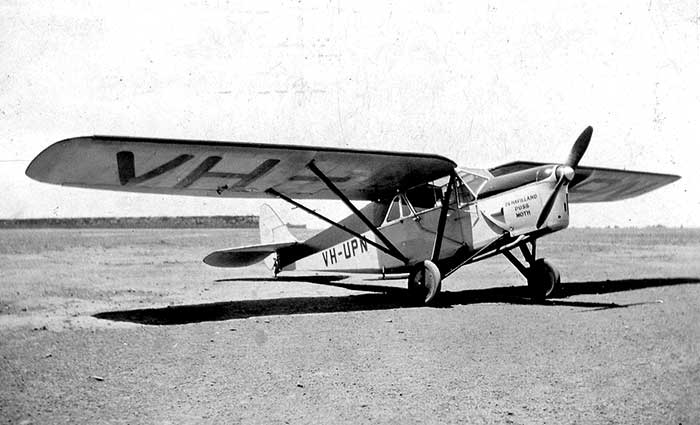
Photo: Civil Aviation Historical Society
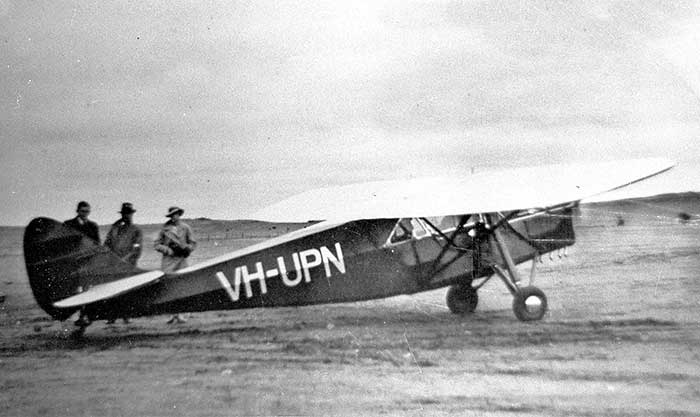
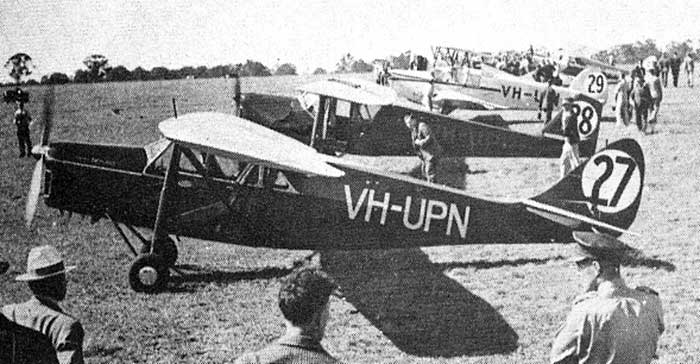
| .30 | Built by De Havilland Aircraft Co Ltd at Stag Lane Edgeware, Middlesex. 120hp DH Gipsy III |
| 10.9.30 | First flight at Stag Lane |
| 11.9.30 | British CofA issued: Q.A.N.T.A.S. Ltd, Brisbane Qld |
| Shipped to Australia to DH agents Qantas Ltd, Archerfield Aerodrome, Brisbane Qld | |
| Assembled from packing crate at Archerfield Qld by Qantas | |
| 13.11.30 |
Qantas Manager Lester J. Brain sent telegram to CAB requesting registration markings for Puss Moths 2084 and 2085
|
| 14.11.30 | Test flown at Archerfield after assembly |
| 14.11.30 | Australian Registration application: Robert W. Reid c/- Robert Reid & Co, Brisbane Qld Robert Reid & Co was a clothing manufacturing and warehousing company. |
| 21.11.30 | Registered VH-UPO: Robert W. Reid, Brisbane Qld |
| 21.11.30 | Australian CofA issued |
| 30.1.31 | Mr. Robert Reid visited CAB office in Melbourne to discuss fitting floats which will be supplied by De Havilland in England. The DH.80 fuselage frame is built with attachment points for floats |
| 26.2.31 | Test flown Archerfield by Reid, after mandatory inspection. CofA renewed |
| 1.3.31 | Fitted with floats by Qantas at Archerfield, named Puss in Boots |
| 3.31 | Flying on floats in Brisbane, pilot Percy H. "Skip" Moody
(Reid's business partner). Moody was an experienced Qantas pilot with 4,000 hours logged, including operating a Ryan B1 on charter in New Guinea. The partnership hoped to promote Government interest in supporting a seaplane airline service between Australia and New Guinea. |
| 7.31 | Arrived at Darwin NT |
| 22.8.31 | Flew at air carnival at Rockhampton Qld |
| 9.31 | CAB memo states that the floats of VH-UPO had twice been replaced by land undercarriage since floats first installed |
| 9.31 | Departed Brisbane on flight to New Guinea, pilot P.H. Moody and engineer Mr. Timewell. Flew north via Cape York, Thursday Island, Daru and Kerema |
| 13.9.31 | Arrived Port Moresby. Moody flew extensive joyrides to raise funds. Later departed Port Moresby on an extended tour to Woodlark Island, Rabaul, Kavieng and Madang |
| 13.10.31 | Moody and Timewell arrived Rabaul, New Britain |
| 11.31 | VH-UPO had overhaul in a shed on the slipway at Rabaul |
| 11.31 | Rwturned to Port Moresby, operating local charter flights and joyrides |
| 12.31 | Returned to Brisbane. The partners agreed they had proven the practicality of a floatplane service in New Guinea, but there was no Government interest. |
| 12.31 | Reverted to conventional wheels undercarriage |
| 7.12.31 | Change of owner name: Robert Reid & Co, Sydney NSW |
| 3.32 | Flew joyrides as landplane at Henty NSW, pilot young Robert Reid |
| 24.5.32 | Inspection report at Mascot |
| 6.7.32 | Forced landing Shoalwater Bay near Rockhampton Qld on an urgent charter flight from Townsville to Brisbane, no damage. Pilot R. Reid. The two passengers continued by rail to Brisbane. |
| 23.9.32 | CofR suspended by CAB for all Australian DH.80 models due structural failures |
| 31.3.33 | Inspection report at Mascot for renewal of CofA after CAB type suspension |
| 11.4.33 | CofR suspension lifted by CAB. Test flown that day at Mascot by Reid |
| 11.2.34 | Undercarriage damaged landing on a beach Jervis Bay NSW due rough surface. No injuries. |
| 14.2.34 | Repairs completed by De Havilland Aircraft Pty Ltd mechanics |
| 18.5.34 | Test flown at Archerfield by Reid after CofA renewal overhaul by QEA |
| 16.11.35 | Test flown at Archerfield by F.C.Higginson after CofA renewal overhaul by R.S.Adair. Airframe time: 875 hours |
| 1.8.36 | Change of ownership: Rockhampton Aerial Services Pty Ltd, Rockhampton Qld Replaced DH.50A VH-UFW which crashed in a forced landing near Capella Qld 19.7.36, on scheduled Brisbane-Rockhampton airline service |
| 1.8.36 | Test flown Archerfield by F.C.Higginson after CofA renewal overhaul by engineer Joe C.Vine |
| 4.9.36 | G.A.Robinson, founder of Airlines of Australia announced that Airlines of Australia had purchased Rockhampton Aerial Services and would take over the Rockhampton-Brisbane and Rockhampto-Colon scheduled services effective 14 September. |
| 14.9.36 | Change of ownership: Airlines of Australia Ltd, Mascot Aerodrome, Sydney |
| 30.7.37 | Forced landing Ocean Beach near Gosford NSW due engine problem: damaged undercarriage, wings and fuselage, no injuries, pilot C. Robinson |
| 12.37 | Change of ownership: Kingsford Smith Air Services Ltd, Mascot Aerodrome, Sydney (wreck) |
| 1.38 | Under rebuild at Mascot by ground engineer Walter Kuhl for Kingsford Smith. It was a significant repair involving correspondence with CAB over a satisfactory repair scheme |
| 31.7.38 | Test flown Mascot after rebuild. Total airframe time: 1064 hours |
| 23.10.38 | Crashed during a forced landing due weather at Gunderman NSW, struck fence. Damage to undercarriage and fuselage. Pilot J. Morton unhurt. |
| 11.11.38 | Test flown Mascot after repairs, pilot C.W.Martin |
| 12.3.39 | Forced landing on Victoria Race Course NSW due engine trouble, no damage. Pilot R. Andrews was conducting joyrides |
| 5.6.39 | Test flown Mascot after CofA renewal overhaul by KSAS |
| 10.39 | KSAS installed tailwheel and brakes |
| 1.12.39 | CofA expired. Total airframe time 1,412 hours. KSAS advise DCA that due to the war situation the Puss Moth will be stored. They intend to install the Gipsy III engine from VH-UPO in their DH.60 Moth VH-UOP which was being rebuilt from a crash 28.2.37. The Moth was urgently needed for RAAF cadet training contracts. (prior to establishment of RAAF EFTS organisation) |
| 9.41 | DCA Mascot office memo: Kingsford Smith's VH-UPO and Royal Aero
club of NSW's Puss Moth VH-UQB are stored while their engines have been
installed in training aircraft. Neither Puss Moth will be made
airworthy at this time. |
| 3.12.42 | 3.12.42 KSAS reply to DCA query over their intentions for UPO that they do not intend to recondition the aircraft unless there is a likely sale. |
| 2.43 | KSAS are negotiating a sale to K. L. Brown, Port Hedland WA. |
| 3.43 | DCA approve the sale under wartime restrictions on civil aircraft, but were unable to approve the fuel ration of an estimated 225 gallons for a ferry flight to Port Hedland. Brown is considering having the aircraft sent to WA by ship. The sale was not completed. |
| 1.7.45 | Change of ownership: Airflite Pty Ltd, Mascot Aerodrome, Sydney NSW Kingsford Smith Air Service Ltd are now incorporated with Airflite Pty Ltd, another established prewar Mascot sales and training company. |
| 12.46 | Sold to: Walter E. James t/a Wollongong & South Coast Flying School, Tom Thumb airfield, Wollongong NSW. Purchased as dismantled airframe, without engine |
| 12.46 | Sold to Norman H. Sutton, Melbourne Vic on behalf of Mrs G. Woods, Western Hotel, Warrnambool Vic |
| 5.3.47 | Change of ownership: Mrs. G. Woods, Timboon Vic. (dismantled airframe) |
| 3.47 | Mrs Woods does not reply to a letter from DCA. No further correspondence in DCA file |
| 28.4.47 | Struck-off Register by DCA |
| Fate unknown |

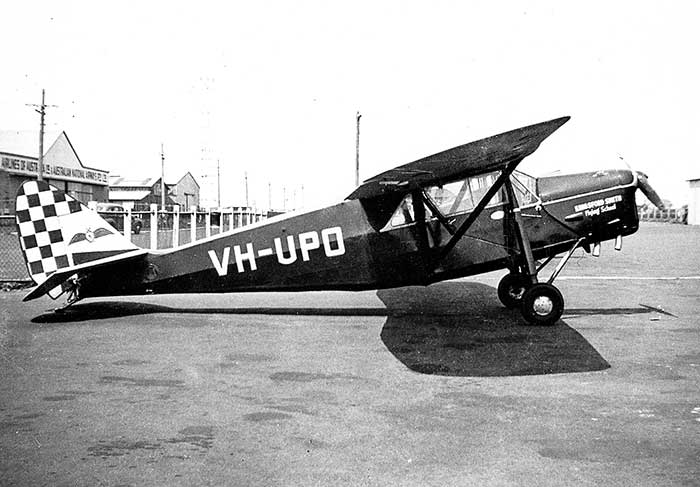
| .30 | Built by De Havilland Aircraft Co Ltd at Stag Lane Edgeware, Middlesex. 120hp DH Gipsy III |
| 10.9.30 | First flight Stag Lane |
| 11.9.30 | British CofA issued: Q.A.N.T.A.S. Ltd, Brisbane Qld |
| Shipped to Australia to DH agents Qantas Ltd, Brisbane Qld | |
| 13.11.30 | Qantas Manager Lester J. Brain sent telegram to CAB requesting registration markings for Puss Moths 2084 and 2085 |
| Assembled from packing crate at Archerfield Qld by Qantas | |
| 13.12.30 | Test flown at Archerfield after assembly |
| 15.12.30 | Austraian Registration Application: Qantas Ltd, Brisbane Qld. Form signed by L.J.Brain |
| 20.12.30 | Qantas certify to CAB that mandatory DH.80 modification have been completed on: VH-UPM owned New England Airways VH-UPO owned Robert Reid VH-UPA & VH-UPQ owned Qantas Ltd |
| 24.12.30 | Registered VH-UPQ Qantas Ltd, Brisbane Qld Used by Qantas on their outback Queensland passenger services and for charter |
| 24.12.30 | Australian CofA issued |
| 23.9.32 | CofR suspended by CAB for all Australian DH.80s following structural failure accidents |
| 22.8.33 | CofR renewed |
| 19.9.33 | Change of ownership: Thomas H. McDonald, Cairns, Qld t/a McDonald Air Service |
| 9.33 | Prior to collecting the aircraft, McDonald requested Qantas to remove the under wing registration and replace it with large painted letters "McDONALD SERVICE" |
| 15.2.34 | Test flown Mascot by A. Murray Jones after annual CofA renewal
overhaul by De Havilland Aircraft. Airframe time: 541 hours |
| 16.8.34 | Test flown Mascot by T. H. McDonald after annual CofA renewal
overhaul by De Havilland Aircraft. Airframe time: 820 hours |
| 27.2.34 | Test flown Archerfield by T. H. McDonald
after annual CofA renewal overhaul by Qantas. Airframe time: 1181 hours |
| 8.7.35 | Damage to undercarriage and fuselage while taxying at Cooktown,
Qld over rough ground, pilot T. H. McDonald, operating as McDonald Air Services. He made temporary repairs and flew the aircraft to Archerfield for repair by Qantas |
| 22.8.35 | Test flown Archerfield after repairs by Qantas. Airframe time: 1476 hours |
| 10.35 | Change of owner name: McDonald Air Services, Cairns Qld |
| 27.10.35 | Puss Moths VH-UPQ & VH-USV departed Saltpan Landing Field, Cairns for Townsville on the inaugural McDonald Air Services scheduled service, pilots T. H. McDonald and George Cannon. At Townsville the flight connects with the air service from Brisbane. |
| 30.6.36 | Change of owner name: North Queensland Airways Pty Ltd, Cairns, Qld. Managing Director Thomas H. McDonald |
| 19.1.37 | Crashed into sea near Cairns Qld. Struck the sea 12 miles north of Cairns a miles off the shore of Yorkeys Knob. A young girl passenger drowned but the pilot C. F. "Pat" Moore and girl's brother were rescued. The aircraft was flying a scheduled service Cooktown-Cairns |
| Visible wreckage was brough ashore on the day but the main wreckage drifted 5 miles to a beach where it was further wrecked by coral and wave action. | |
| Accident investigation concluded that the pilot had fallen asleep and descended gradually into the sea. |

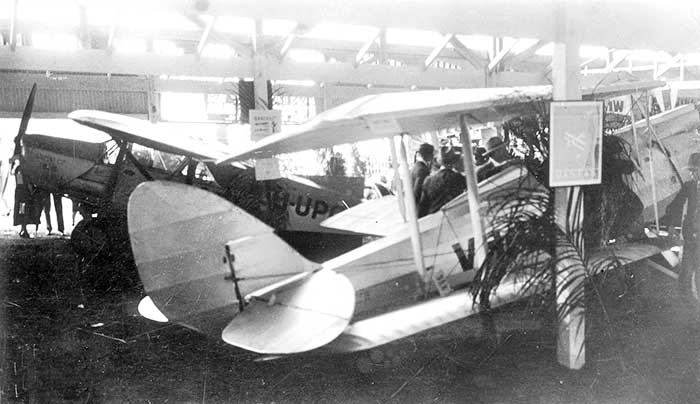
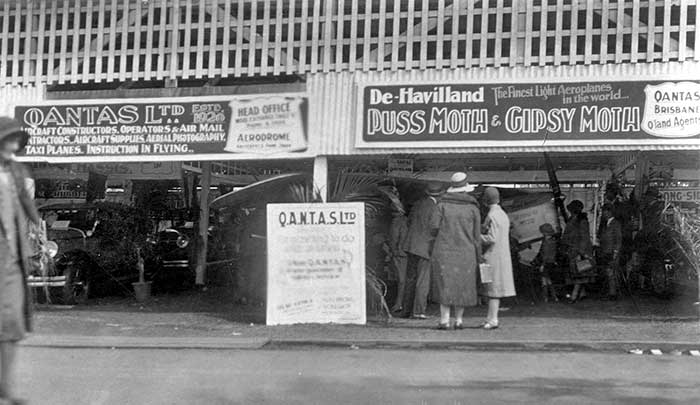
Both photos: Lester Brain collection via AHSA NSW Branch

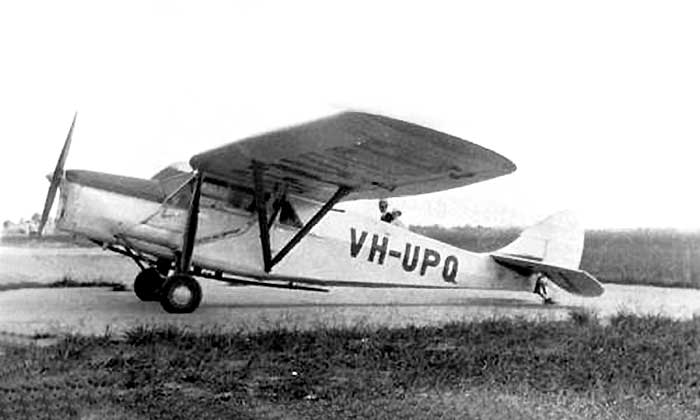
| .30 | Fuselage built by De Havilland Aircraft Co Ltd at Stag Lane Edgeware, Middlesex. |
| Fuselage frame, fittings and Gispy III shipped to De Havilland Aircraft Pty Ltd, Sydney NSW | |
| .30 | One of ten DH.80A fuselages shipped to Sydney to be completed by De Havilland Aircraft at Mascot. Expected sales were not forthcoming, no doubt because of the effects of the Great Depression and the type's reputation due to structural accidents. Stored Sydney pending sale. |
| .32 | H F. Broadbent ordered a new Puss Moth from De Havilland Aircraft Pty Ltd, Mascot |
| 21.6.32 | Assembly completed at Mascot Aerodrome, Sydney using wooden mainplane and tailplane constructed in the company workshops at Mascot. |
| 21.6.32 | First flight Mascot by Hereward De Havilland. |
| 22.6.32 | Inspection report at Mascot and test flown again. Total airframe time: 30 minutes Report states: "Fuselage built by De Havilland in Engand, completed by De Havilland Aircraft Pty Ltd, Mascot who constructed "all covered surfaces". |
| 24.6.32 | Registered VH-UQL: Harry F. ("Jimmy") Broadbent, t/a Sydney Air Taxis, Mascot Aerodrome, Sydney |
| 24.6.32 | CofA issued |
| 32 | "Sydney Air Taxis" painted on the engine cowling and name "Dabs II" |
| 23.9.32 | CofR suspended by CAB for all Australian DH.80s following structural failure accidents |
| 24.3.33 | CofR suspension lifted by CAB after mandatory modifications installed |
| 31.10.33 | Change of ownership: John W. F. Collins, Beaudesert Qld |
| 27.12.34 | Change of ownership: De Havilland Aircraft Pty Ltd, Mascot Aerodrome, Sydney NSW |
| 1.4.35 | Change of ownership: Beverley G. M. Shepherd, Sydney NSW |
| 17.6.35 | Departed Mascot to join the 1935 Mackay Aerial
Survey Expedition of Central Australia. VH-UQL flown by owner Mr.B.G.M.Shepherd, and New England Airways GAL Monospar VH-UTK flown by expedition pilot Frank Neale to be based at Cook SA |
| 22.7.35 | Returned to Mascot from Mackay Expedition |
| 7.2.36 | Fuselage damaged when the aircraft struck a drum while taxying at Mascot, pilot Shepherd |
| 24.4.36 | Change of ownership: Thomas H. McDonald & William D. Lehfeldt, Cairns Qld |
| 12.5.36 | Arrived Cairns on delivery |
| 12.5.36 | Change of ownership: North Queensland Airways Pty Ltd, Cairns, Qld Managing Director Thomas H. McDonald |
| 26.10.36 | Test flown Acherfield by NQAW Chief Pilot Clive Jones, after annual CofA renewal overhaul. Airframe time: 1,366 hours |
| 7.37 | Gipsy III engine replaced by a Gipsy Major |
| 27.1.38 | Test flown Cairns by T.H. McDonald after annual CofA renewal by NQAW. Total time 2,929 hrs |
| 19.5.38 | Damaged landing on rough surface at Chillagoe Qld by NQAW pilot Roy Jowett . While he was on the ground at Wrotham Park Station earlier that day, a station hand walked into the turning propeller and was badly injured. Jowett was rushing the injured man to a doctor at Chillagoe. |
| 6.38 | Under repair at Mascot by De Havilland Aircraft Pty Ltd, after the damaged airfame had been transported from Queensland |
| 17.7.38 | Test flown Mascot by T.H. McDonald after repair |
| 25.10.38 | North Queensland Airlines and its assets taken over by Airlines of Australia Ltd. |
| 19.12.38 | Register Change of ownership: Airlines of Australia Ltd, Sydney NSW |
| 20.1.39 | Test flown at Cairns by Alan Cameron, after annual CofA renewal. Total time: 4,202 hours |
| 18.7.39 | Test flown Cairns by Ian H. Grabowsky, after CofA renewal. Total time: 4306 hours |
| 16.2.40 | Test flown Cairns after CofA renewal. |
| 7.6.40 | Damaged in ground-loop on landing Cooktown Qld, pilot Frank Cohen and 2 passengers uninjured. |
| 12.6.40 | Repairs completed |
| 21.8.40 | Test flown Cairns by Clive Jones, after CofA renewal. Total time: 4531 hours |
| 27.8.41 | Crashed destroyed near Coen Qld when a wing broke away in flight. The aircraft struck the ground 2 miles south of Coen in the circuit area to land to refuel, while enroute from Thursday Island to Cairns on a military charter. Pilot Frank Cohen and passengers Charles Hardy and Lt. Col. T. R. Miller were killed. |
| 8.41 | DCA Chief Accident Investigator John Watkins,
and aircraft inspectors Les Ellis and Jack Shaw were flown from
Melbourne to Coen in the DCA Percival Q6 VH-ABY, pilot Arthur Affleck.
The investigation found that wing collapsed due to excessive flutter in flight |
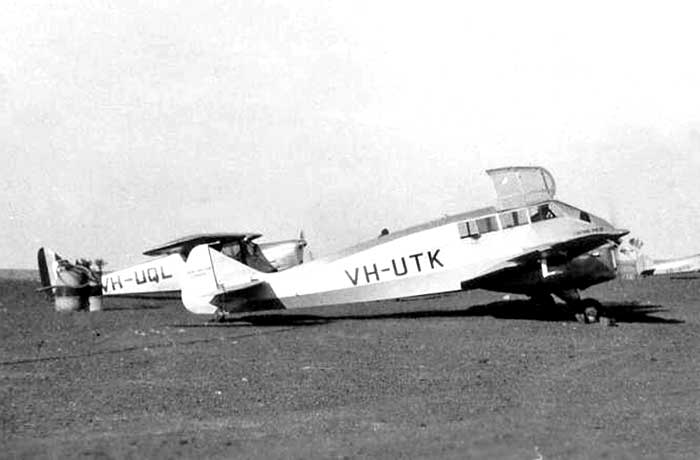
Mackay Aerial Survey Expedition of Central Australia. Robert Milburn collection


| Built by De Havilland Aircraft Co Ltd at Stag Lane Edgeware, Middlesex. 120hp DH Gipsy III. | |
| 23.8.30 | Registered G-ABDW: Captain Froude Ridler Matthews, Highgate, London. Based Stage Lane Aerodrome |
| 11.9.30 | CofA issued |
| Captain Froude Matthews served with Royal Navy during WW1,
gained his pilot licence in 1925 and by 1930 was Chief Flying Instuctor
with the London Aero Club. He purchased the Puss Moth for an attempt to
beat Bert Hinkler's record flight time to Australia of 15 days. | |
| 16.9.30 | Matthews
departed Croydon Aerodrome, London at dawn flying solo in G-ABDW, reaching Belgrade that evening |
| 23.9.30 | Forced
landing near Banmee, Siam 300 miles short of Bangkok. After two hours
flying in heavy rain and thunderstorms Matthews glimped a clear area on
the ground. However it was a quarry and during the landing the aircraft
suffered significant damage to undercarriage, tail and one wing.Matthews was unhurt. |
|
Aircraft transported to Bangkok for repair | |
| 9.10.30 | Resumed flight to Australia after repairs were completed. |
| 18.10.30 | Reached Darwin NT |
| 20.10.30 | Matthews
departed Darwin bound for Sydney. From Darwin he was accompanied by the
Shell Company's DH.60M VH-UNQ flown by Shell's company pilot H.Owen. |
| 23.10.30 | Arrived at Eagle Farm aerodrome, Brisbane to a welcoming crowd. Matthews performed aerobatics before landing |
| 27.10.30 | Departed Brisbane for Lismore NSW where he was given a civic reception. On his departure for Sydney the engine failed shortly after becoming airborne and Matthews made a forced landing in a paddock. The aircraft struck the ground heavily, collapsing the undercarriage and came to rest against a fence, badly damaged. Matthews escaped with a scratched hand. |
| Matthews
was flown to Sydney by Owen in the Moth VH-UNQ. On 3.11.30 they arrived
at Essendon when they were met by 5 Aero Club Moths. | |
| G-ABDW repaired at Mascot aerodrome, Sydney by De Havilland Aircraft Pty Ltd. Extra fuel tankage was installed to increase range for his return flight to England. | |
| 27.12.30 | Matthews departed Sydney in G-ABDW hoping to beat the Australia-England record |
| 5.1.31 | Reached Darwin. Delayed there due poor weather. |
| 14.1.31 | Departed Darwin but returned after flying into severe weather which damaged the wingspar. |
| Keith Virtue recalls in his book Virtue in Flying: “F. R. Matthews, taking off from Darwin for England, had a narrow escape when a wing partially collapsed in mid-air” | |
| Matthews abandoned his record attempt. G-ABDW was shipped from Darwin to Sydney for repairs by De Havilland Aircraft Pty Ltd, arriving Sydney 22.2.31 | |
| After
repair, Matthews originally intended to have the Puss Moth shipped from
Sydney to Calcutta for a planned India-England record attempt. However
he later decided to sell the aircraft in Sydney. | |
| 4.5.31 | Australian Registration application: Douglas F. Shepherd, Bondi, Sydney NSW |
| 16.5.31 | Test flown Mascot after rebuild, pilot Ian H. Grabowsky |
| 19.5.31 | CAB Inspection report at Mascot |
| 27.5.31 | Registered VH-UQB Douglas F. Shepherd, Sydney NSW |
| 7.8.31 | Australian CofA issued. No reason for the delayed issue given in the CAB file |
| 23.9.32 | CofR suspension by CAB for all Australian DH.80s following structural failure accidents |
| 15.2.33 | Change of ownership: Harry R. Clarke, Sydney NSW |
| 2.3.33 | CofR renewed, after mandatory modifications installed |
| 4.3.33 | Damaged on rough surface of landing ground Bingarra NSW, pilot H.R.Clarke |
| 16.3.33 | 1Repairs completed |
| 12.7.34 | Change of ownership: Daniel V. Clifton, Sydney NSW. Clifton wrote to CAB advising he had actually been the owner while Clarke operated the aircraft |
| 7.34 | Change of ownership: N.W.C. Croucher c/- Shell Co, Ayr Qld, later Townsville Qld |
| 20.5.36 | Change of ownership: James C. Pollock & G. P. Hoskins c/- Royal Aero Club of NSW, Mascot Aerodrome, Sydney |
| 15.7.36 | Crashed during landing at Peake Hill NSW, turned over on to back, pilot Pollock unhurt |
| 21.8.36 | Test flown Mascot by Pollock after repair. Total airframe time: 218 hrs |
| 21.8.36 | Change of ownership: James C. Pollock c/- Royal Aero Club of NSW, Mascot Aerodrome, Sydney |
| 19.7.37 | Departed Mascot on the fourth and last Mackay Aerial Survey Expedition
of Central Australia, financed by explorer Donald Mackay. This year's survey area was based in the Tanami Desert WA. Two aircraft were chartered for the Expedition: VH-UQB flown by owner James Pollock and DH.90 VH-UXA owner by Fostar Shoes, with pilot Frank Neale who had flown on previous Mackay expeditions. |
| Pollock
made 37 flights covering 187,000 square miles which included area left
blank between the 1933 and 1935 Mackay expeditions. He reported
difficulty locating the Tanami base on return and arranged smoking
fires. | |
| 23.8.37 | Puss Moth and Dragonfly returned to Sydney on completion of the expedition. |
| 7.38 | Pollock is now a pilot with Airlines of Australia and wishes to sell VH-UQB |
| 13.7.39 | Change of ownership: Royal Aero Club of NSW, Mascot Aerodrome, Sydney |
| 4.8.38 | Test flown Mascot by B.W.Monk after CofA renewal overhaul. Airframe time: 1341 hours. Brian Monk was a club instructor who later changed his surname to Monkton and flew RAAF flying boats during WWII before forming Trans Oceanic Airways, Sydney in 1946. |
| 28.11.39 | Forced landing Ascot Racecourse, Sydney due fuel vapour lock, no damage. Pilot R.E.Bowman |
| 23.2.40 | Test flown Mascot by B.W. Monk after CofA renewal |
| 22.2.41 | CofA expired at Mascot. Not renewed by aero club, which advises DCA that they have no use for the aircraft for some time due to the war situation. Club has removed the engine to use in another Club training aircraft |
| 9.41 | DCA memo: UQB is retired at Mascot and the Aero Club intends to using its Gipsy III engine in a training type aircraft |
| 28.10.44 | Royal Aero Cub of NSW request approval under wartime restrictions on civil aviation to sell VH-UQB to S. D. Marshall at Mascot. Approved. |
| 1.11.44 | Change of ownership: Sidney David Marshall, t/a Marshall Airways, Mascot.
Stored in his hangar for duration of the war, to be later rebuilt |
| 14.11.47 | CofA renewed at Mascot by Marshall Airways. Flown on charter and joyriding for Marshall Airways based Mascot, then moved to Bankstown circa 1951, until finally retired in 1971 |
| 17.7.49 |
Pilot logbook Warren Penny: DH.80 VH-UQB Mascot local flight |
| 22.5.53 | Undercarriage damaged in a ground-loop on landing at Newcastle NSW. Pilot A. H. Barwell |
| 11.1.55 | Struck-off Register as withdrawn from service |
| 22.12.55 | Restored to Register |
| 18.12.59 | Ownership changed to Marshall Airways, Bankstown Airport, Sydney NSW |
| 28.1.60 | While joyriding at Womberal NSW, a passenger was struck by the propeller |
| 28.12.61 | noted at The Entrance NSW, flying joyrides, silver, red trim, "Marshall Airways" on tail |
| 5.10.63 | noted at Bankstown, flying weekend joyrides |
| 8.1.67 | noted at Bankstown, at Marshall Airways hangar, silver with red trim, "Marshall Airways" on tail |
| .71 | Last flight at Bankstown, retired in Marshall Airways hangar, along with Sid Marshall's collection of vintage and historic aircraft. VH-UQB total airframe time 4,150 hours. |
| 17.5.72 | Ownership changed to Sidney D.Marshall, Bankstown Airport, Sydney NSW |
| 30.3.73 | Struck-off Register |
| 73 | VH-UQB and retired Marshall Airways Short Scion VH-UUP were sold to vintage aircraft dealers Hendon Aeroplane Co, Sydney |
| 8.73 | Both resold to Sir William Roberts t/a Strathallen Aircraft Collection, Auchterader, Scotland |
| .74 | Shipped from Sydney to Great Britain |
| 4.74 | Arrived at Strathallan Collection by road from port |
| 25.3.77 | Restored to British Register: G-ABDW Strathallan Collection, Strathallen airfield, Auchterader, Scotland |
| Displayed in collection. Not restored to airworthy | |
| 14.7.81 | The closed Strathallan
Collection was sold by auction by Christies of London. Lot 74 was Puss Moth VH-ABU, sold for £7500 to Royal Scottish Museum, East Fortune, Scotland |
| Displayed at the former wartime East Fortune airfield, as VH-UQB in Marshall Airways markings. The Australian modification of additional strut between undercarriage and wing has been removed but it retains the Gipsy Major engine which replaced the Gipsy III during Australian service. | |
| 21.1.82 | Struck-off Civil Register |
| Currently displayed East Fortune, Scotland painted as VH-UQB |
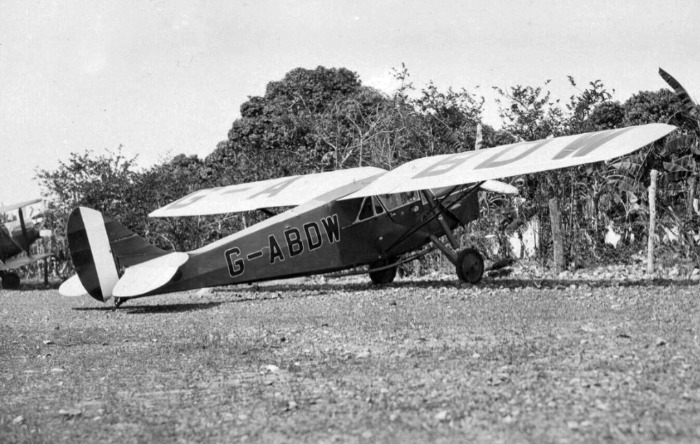
Puss
Moth G-ABDW after arrival in Australia 1930.
National
Library of Australia
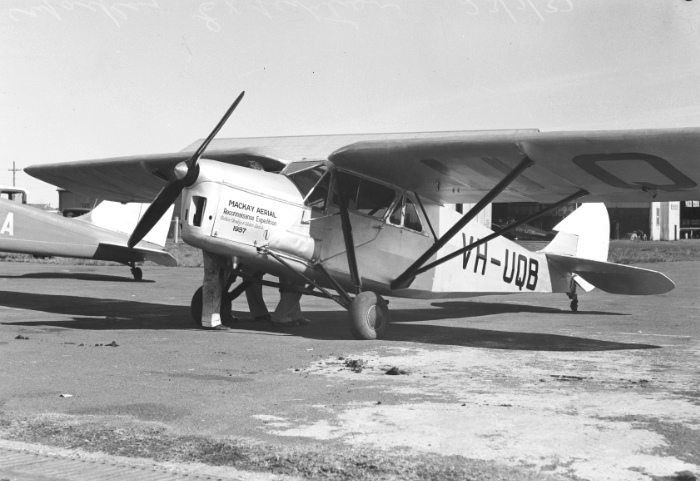
Expedition Northern Territory and Western Australia 1937". State Library of NSW
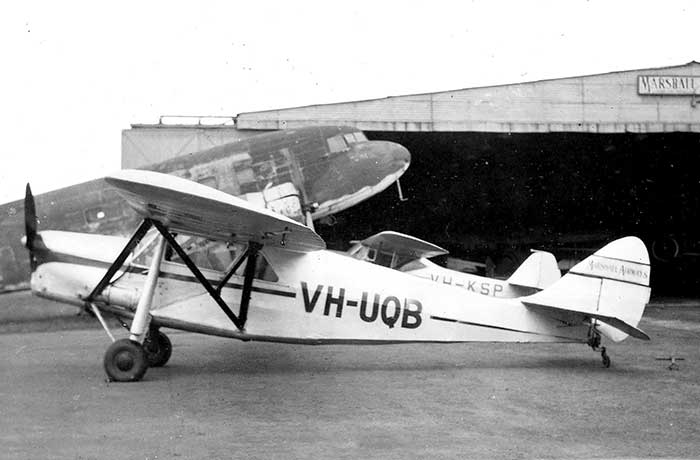
acquired by Sid Marshall and stored at the hangar. Photo by Jeff Atkinson
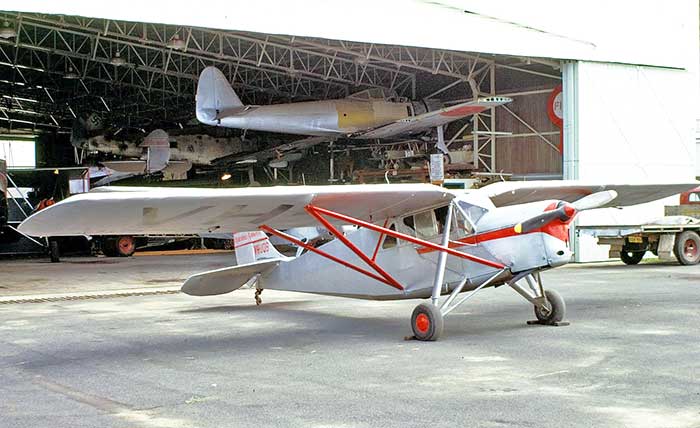
the rafters to free up floor space. Visible are a Najakima Oscar, Messerschmitt Bf 109 and Avro Cadet.
Photo: Civil Aviation Historical Society
| .30 | Fuselage built by De Havilland Aircraft Co Ltd at Stag Lane Edgeware, Middlesex. |
| .30 | Fuselage frame, fittings and Gispy III shipped to De Havilland Aircraft Pty Ltd, Sydney NSW |
| One of ten DH.80A fuselages shipped to Sydney to be completed by De Havilland Aircraft at Mascot. Expected sales were not forthcoming, no doubt because of the effects of the Great Depression and the type's reputation due to structural accidents. Stored Sydney pending sale. | |
| .32 | Order for a new DH.80A received from Mr. T. P. Manifold, Victoria. This was part of a deal negotiated by Major Hereward De Havilland, founder of the Australian DH company, to assemble and sell one the stored DH.80A fuselages. Manifold would trade in his used DH.80A VH-UPJ which Hereward and his wife Mrs. Jesse De Havilland, who had learnt to fly, would purchase for their personal use. |
| .32 | Assembled at Mascot Aerodrome by De Havilland Aircraft Pty Ltd, using wooden mainplane and tailplane constructed in the company workshops at Mascot. |
| 16.3.32 | De Havilland Aircraft Pty Ltd wrote to CAB advising that they are presently erecting a Puss Moth serial number 2067 for Mr. T. P. Manifold and requested registration marking |
| 5.4.32 | Test flown at Mascot by Hereward De Havilland |
| 12.4.32 | Registered VH-UQK: Thomas Peter Manifold, "Wiridgil", Camperdown Vic |
| 12.4.32 | CofA issued |
| 23.9.32 | CofR suspended by CAB for all Australian DH.80s following structural failure accidents |
| 16.6.33 | Test flown Essendon by G. Jenkins after completion of mandatory modifications by Matthews Aviation. Airframe time 61 hours |
| 20.7.33 | CofR renewed |
| 25.9.33 | Change of ownership: Alexander M. Bayne, Melbourne Vic |
| 24.2.34 | Forced landing near Westerport Vic, due sparkplugs oiling up, no damage. Pilot A.M. Bayne |
| 25.2.34 | Forced landing Yanakie, Tasmania due sparkplugs oiling up, no damage. Later on the same day another forced landing at Launceston Tasmania due excessive fuel consumption. No damage. Pilot Bayne |
| 3.3.34 | Bayne flew Hobart-Launceston, Tas with rough running engine due spark oily plugs |
| 4.3.34 | Forced landing 17 miles south Launceston due plugs oiling up, no damage. Pilot Bayne |
| 3.34 | CAB investigation into the engine, which had just
completed an overhaul by Larkin Aircraft Supply Co, Coode Island Aerodrome, Melbourne. Proprietor J. J. Larkin, a severe critic of Government aviation administration, wrote a strong letter to CAB objecting to their inspector approaching his engineer directly, instead of through himself. He blamed the problems with VH-UQK's engine on the owner who he accused of using incorrect oil to save on costs. |
| 4.5.34 | CAB Inspection report at Essendon, good condition |
| 23.7.34 | Change of ownership: Owen Frank Y. Thomas, Hillston NSW |
| 26.1.35 | Test flown Mascot by owner Frank Thomas after CofA renewal. Airframe time 433 hours |
| 2.35 | Thomas flew UQK to Tasmania for a joyridng tour |
| 11.2.35 | Damaged undercarriage and starboard wingtip in a heavy landing in a paddock near Latrobe, Tasmania. Pilot Frank Thomas and his passenger were unhurt. |
| 13.2.35 | Thomas flew UQK to Launceston after temporary repairs at Latrobe. Full repairs carried out by Holymans Airways |
| 5.10.35 | Test flown Mascot by Thomas after CofA
renewal by De Havilland Aircraft Pty Ltd. Airframe time: 605 hours |
| 9.10.35 | Departed Mascot for Darwin on flight to England, flown by Frank Thomas and F. R. Maguire. The aircraft would be sold in Britain after arrival |
| 11.10.35 | Departed Darwin |
| 10.11.35 | Arrived at Lympne |
| 7.5.36 | Struck-off Australian Register |
| 15.5.36 | Application for British CofA by Brooklands Aviation Ltd, Brooklands |
| 27.5.36 | Registered G-AEIV O. F. Y. Thomas, London Registered in his name to facilitate British certification and early sale. Frank Thomas returned to Australia and went on to a long flying career with Qantas Empire Airways |
| 20.6.36 | British CofA issued |
| 29.6.36 | Change of ownership: Geoffrey R. D. Shaw, Sywell |
| 14.9.38 | Change of ownership: Frederick E. Tasker, Hatfield |
| 23.5.39 | Change of ownership: Reginald J. Salmon, Hatfield |
| 19.3.41 | Civil Registration cancelled by Secretary of State |
| 25.3.41 | Impressed by Ministry of Defence as DP853 |
| DP853 operated by HQ Air Transport Auxiliary, White Waltham. Flown in camouflage with RAF markings. ATA provided pilots to ferry military aircraft throughout Great Britain during WWII. | |
| 25.7.42 | Allocated to No.5 Maintenance Unit, Kemble |
| 8.9.42 | Conveyed to Gatwick Airport for major inspection by civil contractor |
| 29.9.42 | Not economic to rebuild. Struck-off Ministry of Defence charge |
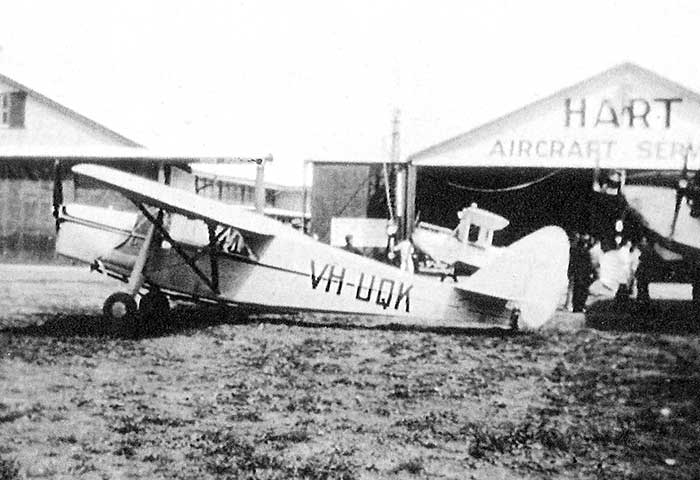

Geoff Goodall collection
| .30 | Fuselage built by De Havilland Aircraft Co Ltd at Stag Lane Edgeware, Middlesex. |
| .30 | Fuselage frame, fittings and Gispy III shipped to De Havilland Aircraft Pty Ltd, Sydney NSW |
| One of ten DH.80A fuselages shipped to Sydney to be completed by De Havilland Aircraft at Mascot. Expected sales were not forthcoming, no doubt because of the effects of the Great Depression and the type's reputation due to structural accidents. Stored Sydney pending sale. | |
| 33 | With
Australia coming out of the Depression, De Havilland Aircraft Pty Ltd
decided to complete one of their stored DH.80A fuselages because a sale
was likely |
| 24.11.33 | CAB write to De Havilland Aircraft at Mascot enquiring about the status of DH.80 serial number 2089 which was allocated VH-UQO some time ago but for which no application for Registration has been received. |
| 27.11.33 | De Havilland Aircraft Pty Ltd replied that they expect to have the machine in service early in the New Year |
| 20.2.34 | Assembly completed at Mascot Aerodrome, Sydney. The wooden mainplane and tailplane had been built built in the company workshops at Mascot |
| 24.2.34 | First flight Mascot by Murray Jones after assembly. All over silver with black trim. |
| 24.2.34 | Australian Registration application: De Havilland Aircraft Pty Ltd, Sydney NSW. In the section Year of Construction: "DH Co England 1930. DH Co Australia 1934". |
| 27.2.34 | Registered VH-UQO |
| 27.2.34 | CofA issued |
| The
aircraft was intended for James Melrose, a 20 year old pilot from a
wealthy Adelaide family. Melrose wanted a suitable aircraft to fly solo
to England and break air records. | |
| Leased pending purchase to James Melrose, Adelaide SA. DH Aircraft Pty Ltd's manager Major Murray Jones tutored Melrose with his flying exams and endorsed him on VH-UQO at Mascot, and several days later Melrose flew it to Adelaide | |
| 5.34 | Melrose flew VH-UQO
Adelaide-Sydney for modifications by De Havilland Aircraft to prepare for his planned long-distance flights. The Gipsy
III engine was replaced by a Gipsy Major with a Fairey-Reed metal prop and additional fuel tankage
installed. Wheel spats were fitted and wing roots were faired over. |
| 13.7.34 | VH-UQO christened My Hildergarde at Mascot, named after his mother |
| 16.7.34 | Change of ownership: Charles James Melrose, Adelaide SA |
| 16.7.34 | Flown Sydney-Adelaide by Melrose |
| 7.8.34 | James Melrose departed Parafield on an attempt to break H. F. Broadbent's record flight around Australia. The route was via Sydney, Brisbane, Townsville, Wyndham, Broome, Carnarvon, Perth. Returned to Parafield on 12.8.34 in a record time of 5 days 11 hours. (Beating the previous record time by Jim Broadbent by 1 day 21 hours) |
| 20.8.34 | Test flown at Mascot by Melrose after CofA renewal overhaul by DH Aircraft |
| 17.9.34 | Melrose
departed Parafield for Alice Springs and Darwin, en route to England to
enter the MacRobertson Centenary Air Race. He flew solo and hoped to
break the record time Darwin-London. |
| 20.9.34 | Departed Darwin. |
| 28.9.34 | Landed at Croydon Aerodome, London at 7am. His time Darwin-London was 8 days 9 hours. 21 year old Melrose had broken by 3 hours the previous record Darwin-London set by Ken Waller and Berenard Rubin in DH.85 Leopard Moth G-ACLX in May that year. |
| 20.10.34 | Air Race competitors departed Mildenhall. Melrose was last to be flagged off at 6.45am in VH-UQO as Race No. 16 in the MacRobertson Centenary Air Race to Melbourne. He was the youngest competitor and flew solo. |
| 30.10.34 | Crossed
the finish line at Flemington Racecourse, Melbourne as the seventh
aircraft to complete the course. Competitors then flew on to land at RAAF Laverton, just south of Melbourne. Melrose was placed 2nd in the Handicap Section with a prize of £500. |
| 13.11.34 | Melrose arrived home at Parafield in UQO, to a welcoming crowd of 2,000 |
| 20.11.34 | Melrose flew VH-UQO to 20,000 feet from Parafield to break the SA altitude record |
| 13.12.34 | Melrose
flew VH-UQO frm Parafield to Wynyard Tasmania in 5 hours, then
with an escort of aero club aircraft made a tour of Tasmanian towns. |
| 20.12.34 | Melrose flew VH-UQO Launceston to Sydney direct in 5 hours |
| 24.1.35 | Melrose flew VH-UQO from Parafield to Melbourne then Sydney, to deliver to his friend Jimmy Broadbent |
| 31.1.35 | Change of ownership: Harry F. ("Jimmy") Broadbent, Sydney NSW. Named Dabs III |
| 18.3.35 | Test flown at Mascot by Broadbent after CofA renewal overhaul by DH Aircraft |
| 5.35 | Broadbent regained his Around-Australia Record from James Melrose, by flying the same route around the Australian coastline in 3 days 9 hours 54 mins |
| 4.10.35 | Test flown at Mascot by Broadbent after CofA renewal overhaul by DH Aircraft. Airframe time 556 hours |
| 10.10.35 | Broadbent departed Darwin on an attempt to beat the Australia-England record |
| 14.10.35 | Undercarriage collapsed in forced landing Bushire, near Basra, Iraq. Record flight abandoned |
| 15.10.35 | Aircraft sold at Shaibah to Flying Officer
Edward H. Wheelwright, 84 Squadron, RAF Shaibah, Iraq. Sold as a complete but damaged aircraft, less Sperry artificial horizon |
| Shipped to England. It has also been reported that the aircraft was repaired locally and flown to England. | |
| 6.3.36 | Registered G-AEEB Flying Officer Edward H. Wheelwright, RAF Eastchurch |
| 13.3.36 | British CofA application by Airworthiness Ltd, Gravesend |
| 3.36 | Previous owner James Melrose was in England to take delivery of his new Heston Phoenix VH-AJM and recorded in his diary his pleasure at seeing his old Puss Moth at Gravesend. He was presented with the original propeller, which he carried back to Australia in the Phoenix, and the propeller was mounted on the sitting room wall of his home in Adelaide |
| 4.4.36 | Struck-off Australian Register |
| 23.6.36 | British CofA issued |
| 15.12.36 | Change of ownership: Henry M. Mitchell, Castle Bromwich |
| 24.5.38 | Change of ownership: Brig. Genl. Arthur C. Lewin, Upton-on-Severn, Worcester |
| 2.10.39 | CofA lapsed. Not renewed due war situation |
| Assumed scrapped during WWII | |
| 28.11.45 | Struck-off Register in census of surviving civil aircraft |
| Note: In 1991 the DH.85 VH-UUL flew at Melbourne painted as
"VH-UQO My Hildegard" to represent the James Melrose entry in the
1934 Centenary Air Race for a TV movie "The Great Air Race", most flying scenes
being filmed at RAAF Point Cook, Victoria |
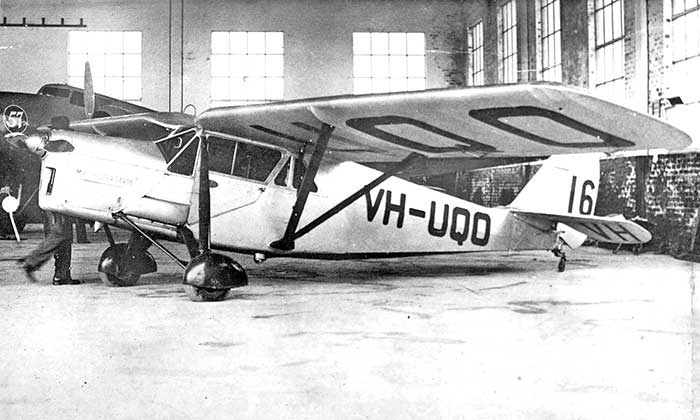
Photo: Civil Aviation Historical Society
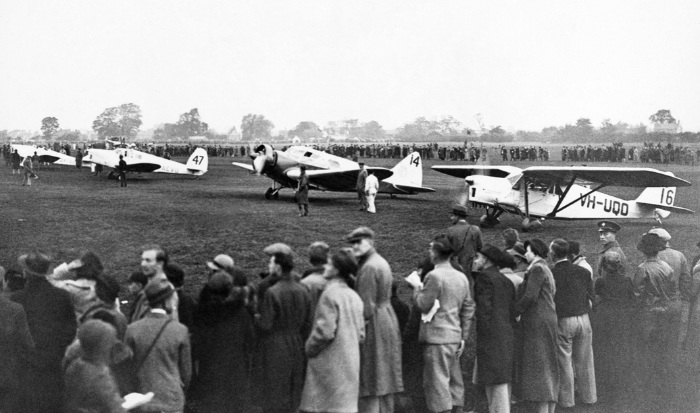
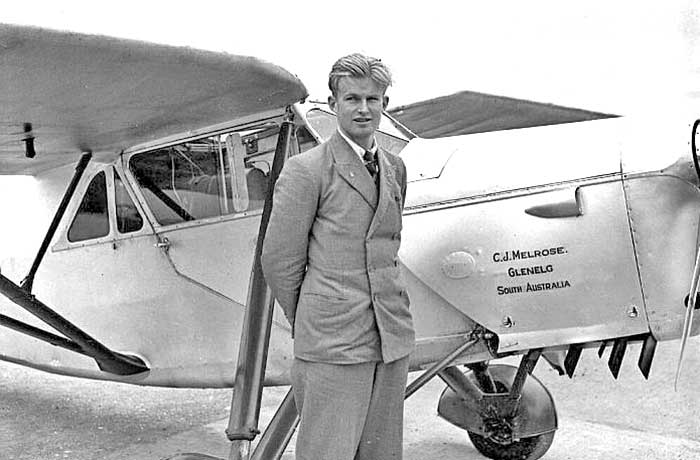
Photo: South Australian Aviation Museum
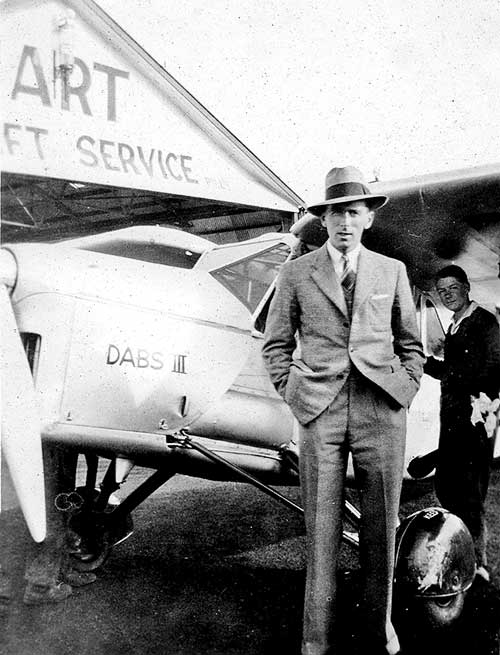
Nigel Daw collection
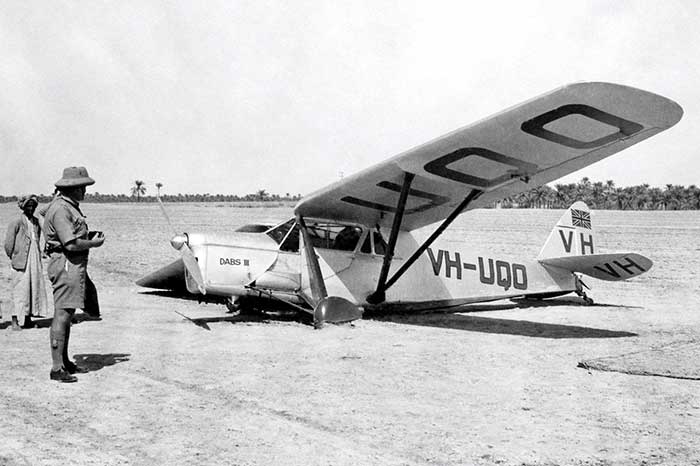
Photo: John Hopton Collection
| .30 | Fuselage built by De Havilland Aircraft Co Ltd at Stag Lane Edgeware, Middlesex. |
| Fuselage frame, fittings and Gispy III shipped to De Havilland Aircraft Pty Ltd, Sydney NSW | |
| One of ten DH.80A fuselages shipped to Sydney to be completed by De Havilland Aircraft at Mascot. Expected sales were not forthcoming, no doubt because of the effects of the Great Depression and the type's reputation due to structural accidents. Stored Sydney pending sale. | |
| 34 | Construction
commenced at Mascot when ordered received for a new DH.80 from Tom
McDonald at Cairns Qld. Fitted with wooden wings and tailplane built by
De Havilland Aircraft at Mascot |
| 5.11.34 | Civil Aviation Branch allocated VH-USV to De Havilland Aircraft Pty Ltd, Sydney for a DH.80 |
| 17.7.35 | Registered VH-USV Thomas H. McDonald, Cairns Qld |
| 17.7.35 | CofA issued |
| 10.35 | Change of owner name McDonald Air Services, Cairns Qld |
| 27.10.35 | Puss Moths VH-UPQ & VH-USV departed Saltpan Landing
Field, Cairns for Townsville on the inaugural McDonald Air Services
scheduled service, pilots T. H. McDonald and George Cannon. At Townsville the flight connects with the air service from Brisbane. |
| 30.6.36 | Change of owner name North Queensland Airways Pty Ltd, Cairns, Qld Managing Director Thomas H. McDonald |
| 18.10.36 | Crashed at Mount Garnet Qld. Crashed on takeoff on
the edge of the small town, North Queensland Airways pilot John A. Bonnington and a lady passenger both injured. The airline founder Tom McDonald flew a doctor from Cairns |
| CAB investigation found that the takeoff length was inadequate. Pilot had attempted to abandon the takeoff but crossed a ridge and struck the ground on the other side | |
| North Queensland Airways ground engineer Jack Atkinson later wrote: "In 1936 we lost a Puss Moth VH-USV at Mount Garnet fortunately without loss of life although Miss Monica Osborne was very serously injured." | |
| 30.6.37 | Struck-off Civil Register |
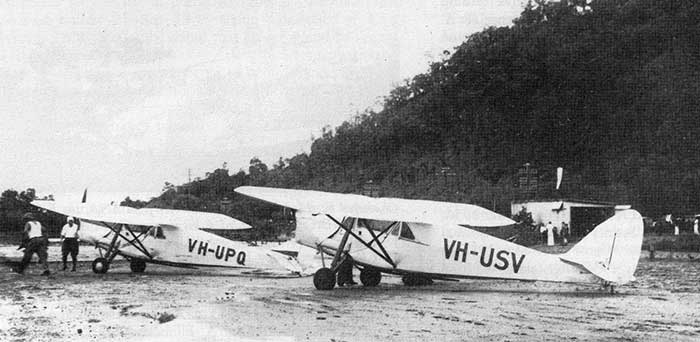
The site is now the southern end of Cairns International Airport. Photo: State Library of Queensland
These were expected to be completed in Sydney using wooden mainplane and tailplanes built in the DH workshops at Mascot Aerodrome by their own skilled woodwork tradesmen, experienced from construction and repair of DH.60 Moths. Unfortunately by the time the incomplete DH.80As reached Sydney, the worldwide Great Depression had hit and sales potential for new aircraft was low. Not helping were doubts over the airworthiness of the type and a series of groundings ordered for the Australian aircraft, which left a stigma over the Puss Moth in Australia. The ten incomplete imports were put into storage in Sydney.
They were: c/ns 2066, 2067, 2078, 2079, 2086, 2087, 2088, 2089, 2094, 2095
| Reg | C/n | Fuselage built Stag Lane | Completed Mascot | Customer |
| VH-UQK | 2067 | 1930 | April 1932 | T.P.Manifold Vic |
| VH-UQL | 2088 | 1930 | June 1932 | H.F. Broadbent, NSW |
| VH-UQO | 2089 | 1930 | February 1934 | J. Melrose, SA |
| VH-USV | 2066 | 1930 | July 1935 | T.H.McDonald, Qld |
It is assumed that the remaining fuselages were returned to the parent DH company. The Gipsy III engine assigned to c/n 2086 was back at Stag Lane to be installed in c/n 2205 on the British production line in August 1931.
| .30 | Built by De Havilland Aircraft Co Ltd at Stag Lane Edgeware, Middlesex. 120hp DH Gipsy III |
| Shipped to Canada without British CofA to De Havilland Canada | |
| 29.4.31 | Registered CF-APK Herbert J. L. "Bert" Hinkler, Toronto, Ontario. Named Karohi |
| 20.10.31 | Hinkler departed Toronto on an attempt to be as first aircraft to fly the South Atlantic from west to east: 26.10.31 Departed New York, flew to Kingston Jamaica non-stop 18 hrs 15 mins Routed via Venezuala, Natal, Bathurst, Senegal, Casablanca, Madrid to England. 7.12.31 Arrived Hanworth, England |
| 7.5.32 | Canadian CofA expired. Stored at RAF Hendon |
| 12.32 | Overhaul, fitted with Gipsy Major engine |
| 7.1.33 | Hinkler in CF-APK departed London Air Park, Hanworth for Australia in an attempt to break the current England-Australia record of 8 days 20 hours. Later that day failed to arrive Brindisi, Italy |
| 7.1.33 | Crashed near Arezzo, Italy in Prato Magna Alps. Structural failure of the wing while flying in turbulence over the Italian Alps. |
| Search failed to locate the missing aircraft | |
| 27.4.33 | Wreckage and Hinkler's body located in Tuscan Mountains near Castel Fancodisopra |
| Note: "CF-APK" displayed at Hinkler Hall of Aviation, Bundaberg Qld is VH-ABU c/n 2022: see above |
23 year old Swiss pilot Carl Nauer flew Puss Moth CH-326 solo to Australia in 1933. He departed Dubendorf on 9 March 1933 and damaged the aircraft on landing at Alor Star on March 27 where he was delayed 5 weeks. He reached Darwin 12 May 1933, arrived Brisbane 25 May, then to Sydney where he arranged to have the aircraft packed up and shipped to Cape Town, South Africa. After travelling to South Africa by sea, he set off to fly from South Africa to Switzerland, but disappeared along the Congo River on 6 August 1933 and was never found.
A month before the Centenary Air Race from London to Melbourne, Lord Sempill departed England on 28 September 1934 in his Puss Moth G-ABJU on a leisurely trip to take part in the Melbourne Centenary celebrations. G-ABJU was registered to Master of Sempill an based on his private airstrip on the family farm The Lizard.
He visited New Guinea and departed Port Moresby for Cairns 18 December 1934 then made a forced landing near Muckandilla 3 days later when unsure of position and spent the night camped under the wing. On arrival in Sydney he was critical of the lack of night flying facilities in Australia and the lack of aeronautical maps for the inland areas.
After Melbourne he flew to Adelaide and arrived at Maylands Aerodrome, Perth 4 February 1935. He departed Perth 10 February to fly north along the WA coast making a forced landing on a beach near Roebourne due to weather, continuing next morning to Port Hedland. G-ABJU departed Wyndham WA for Koepang, Timor on 17 February 1935 on his return flight to England.
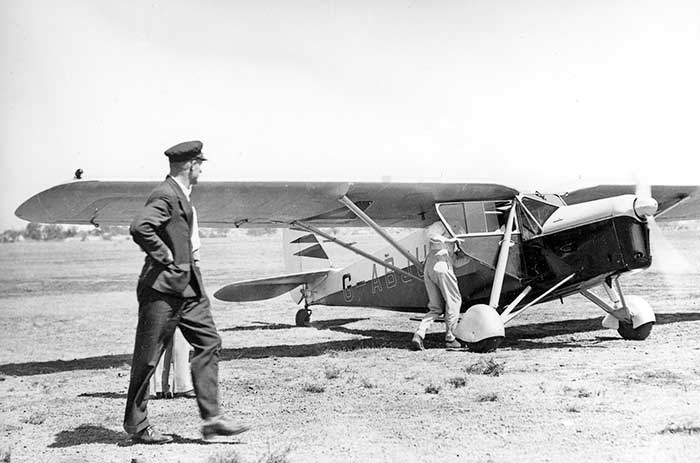
Owned by Francis C. Chichester and F. D. Herrick was shipped from NZ to Sydney, arriving 19 June 1936. Assembled at Mascot, departed 26 June for England, via Darwin, Indochina, China, India and Europe. Arrived at Brooklands 12 October 1936. Sold in England as G-AFDH.
G-AAZP c/n 2047
The 50th Anniversary of 1934 London-Australia Air Race was celebrated at Mildenhall on 21 October 1984 with a hangar dance. Next morning G-AAZP named British Heritage departed on first leg of a commemorative fight to Melbourne, escorted by 20 aircraft. It was flown by owner Tim Williams, accompanied by flying enthusiast Henry Labouchere.
Reached Essendon Airport, Melbourne on 8 December 1984 after 150 hours flying over 61 days, following the route used Jimmy Melrose in his 1934 Air Race solo flight in his Puss Moth. G-AAZP flew to Mount Shank airfield SA near Mount Gambier for servicing by Don McBain, who Henry Labouchere knew from his previous flying in South Australia. It was seen at Mount Shank on 15 December 1984 and parked at Drage Airworld, Wangaratta Vic in January 1985 on loan for display. Shipped back to Britain, arrived Tilbury Docks, London 23 February 1986.
G-AAZP is still flying in Britain
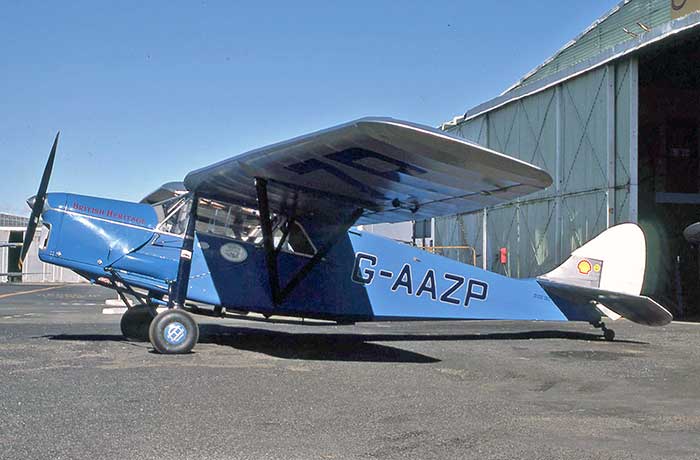
Puss Moth airworthiness correspondence 1932-1934
A collection of personal papers of Edgar C. Johnston, Controller of
Civil Aviation is held by the Civil Aviation Historical Society at
Essendon Airport. Thanks to this invaluable collection, we are
given an insight to the concern over Puss Moth accidents in remarkably
personalised correspondence with the senior officer of the Civil
Aviation Branch. These extracts were compiled by aviation historian John Hopton :28 January 1932: Johnston to Alan Murray-Jones, De Havilland Aircraft Pty Ltd, Mascot:
When in November last I noticed the press report of a “Puss Moth” in South Africa failing in the air, I cabled South Africa asking whether the machine had been modified in accordance with De Havilland drawings No.s M.1560 and M.1632.
You may be interested to know that the reply just received states that Modification M.1560 had been incorporated but M.1632 was not incorporated as the aircraft was fitted with strengthened type of rear spar and quadruple brace as in latest aircraft received from De Havillands. The cable also reports that the wreckage had been despatched to the Air Ministry for examination and a copy of the full report has been promised me as soon as available.
02 February 1932: Murray-Jones replied:
The information forwarded by you regarding the Puss Moth in South Africa, explains the action of Stag Lane in instructing us to incorporate M.1632 on all machines irrespective of the type of rear spar fitted, and all Puss Moths are so fitted.
We are only just in receipt of a cable from Stag Lane referring to that crash. It states that the Air Ministry and our people had examined the wreckage conjointly and had found that the “Unanimous decision primary breakage front strut under down load spar failure secondary stop Kidston accident similar stop Good reason believe all failures have been strut under down load stop Matthews unique and due some previous damage stop Numerous sand test confirm front strut weakest link down load but above required factor stop Failure in air either due abnormal down gust or excessive speed in dive in fog with possible secondary forces on strut.” It is further added that a simple modification is being issued and parts will be supplied to all owners. This will double the strength of the front strut and eliminate the possibility of failure of the strut.
By this time you will have received by official request to have the all-up loading of VH-UPO revised, and I think that you will see from the above that there is every justification for what we have said about the action of the Department.
You will agree that there is every indication that, throughout the history of the Puss Moth failures, the Company has been extremely honest in its endeavour to have the trouble straightened out satisfactorily to owners. In this endeavour it appears to have had the sympathetic assistance of the Air Ministry, in recognition of the fact that the problems involved were not easily soluble, and required co-operation rather than the mandatory aspect of the work of the Department.
I have made the above statement as I am under an impression - mistaken, probably - that you have been inclined to the belief that the Air Ministry is sheltering the mistakes of one of its approved Contractors in order to bolster up a system of control effete and ineffectual.
We ask you to look at all the facts afresh, when we are sure that you will realise that, in its official endeavours to check up the work already done by others, the Department has been unfortunate enough to strike difficulties which can be solved only by empirical methods, and which, therefore, must be left entirely in the hands of the constructor, whose good name will inevitably suffer if a satisfactory solution be not found.
In the Puss Moth we have a machine which has revolutionised light aeroplane design. We ask for sympathetic treatment by the Department, knowing full well that only very abnormal conditions have occasioned the trouble in the past, and that manufacturers are leaving no stone unturned to ensure that the design will be satisfactory under all possible flight conditions.
In my official letter I have stressed the legal difficulties which may result from the action of the Department, and I am sure that you fully appreciate that aspect. Could you let me have an answer regarding loading in a few days.
22 August 1932: Johnston to Murray Jones: Regarding press reports of Puss Moth G-ABDH near Hindhead, Surrey on 27 Jul 32, expressing doubts as to the efficiacy of modifications so far undertaken to the Puss Moth design.
Reports stated that the aircraft collapsed in the air. Being still somewhat suspiciously minded I enquired from London as to the type of aircraft and was informed in reply that it was a “Puss Moth” and that the machine broke in the air under abnormal stress due to bad flying conditions. The reply further stated that apparently one wing collapsed under the abnormal load. I have since enquired as to whether the wings were modified and, if so, to what extent and was informed in reply that all the modifications approved to date were incorporated in the machine which was covered by regulation certificate of airworthiness. The investigations as to the accident are, I understand, still proceeding, and I expect to be advised of the result in due course.
I think that you will agree that the whole thing is most disturbing, and you can imagine it is causing me a certain amount of worry, as probably it is to you. However, I do not feel disposed to take any further action about “Puss Moths” in Australia until I hear the result of the Air Ministry’s investigation into the present case; . . . .
24 August 1932: Murray Jones replies:
Our people in England are confident that the machine is up to the strength when properly used. From what I can gather from the reports of the accident, which appeared in the local press, the flight was undertaken under the most adverse conditions, when visibility was extremely bad and a violent storm was raging. I think that under the circumstances, we must be very guarded in drawing any conclusions from the accident, at any rate, until the report of investigation is complete.
It seems to me that light aircraft, like light sea-going craft, will have to realise that certain weather conditions are definately dangerous, and in battling through a bad storm a certain element of risk seems inevitable.
I have just received a Beam message from Stag Lane giving details of Mollison’s flight. His Puss Moth was loaded to 2754 lbs. - i.e. it had a 700 lbs., or approximately 35% overload. Apart from tankage it was a standard machine and engine, and with it he flew through the storms that are met with on the Atlantic crossing, doing quite a lot of blind flying. There would appear to be no doubt of the strength of the machine after his flight and that of Hinkler, who encountered very bad weather in his crossing to Africa, and who was also flying an overloaded machine.
I know that you appreciate the fact that our people at Stag Lane will have been most disturbed by the failure of another Puss Moth, and will have taken every possible action to endeavour to ascertain the cause, and that if any further modifications appear to be necessary, they will not hesitate to have them promulgated.
In this country, I think that the only line of action is that adopted at present when you demand a careful inspection of the wings each year. After all, apart from that unfortunate West Australian affair, Puss Moths have done a very large amount of flying in Australia, under conditions which must have tried them out. They have always performed well, and have stood up to racing and aerobatic work without a sign of trouble after our change of spars. In view of this, I should certainly be guided by the action taken by the Air Ministry after the enquiry. You may be sure that if anything can be done, it will be done in England, and that no difficulties will be placed in the way of Air Ministry officials by the Company, in their endeavours to find where the fault, if any, lies. The De Havilland Aircraft Co. Ltd. must be more interested in the performance of its products than even the Air Ministry, as its very existence depends on their success.
13 September 1932: Hudson Fysh, Managing Director of Qantas Ltd to Johnston :
Discussions had been under way on the proposal to link the United Kingdom to Australia for the operation of an Empire Air Mail Service and the type of aircraft to be used. The effects of the depression and consequent revenue losses had caused a reconsideration of values used to calculate depreciation of the extant fleets, ensuring the retention in use for a longer period than intended of older and in many instances, unsuitable machines.
In regard to machines for the commencement of the services, I strongly feel that the only sound plan is to use what is available at present, testing conditions out thoroughly, then as a result of that experience placing new types in commission. Another point in connection with this is that new types could not be operated for the same cost as present equipment. A low operating cost through using a small machine of say the Puss Moth type would only be obtained at too great a cost in other directions. I could not imagine our Route being operated by Puss Moths, it would be the laughing stock. The only possible way in which it could be done on the Brisbane-Darwin route would be to use Puss Moths on the Camooweal-Darwin stage, but even then there would be no surplus space for a peak mail or for an odd urgent passenger and freights. Then the Puss Moth would have to link with a large machine flying the Timor - no, I do not think it could be done.
8 November 1932: Fysh of Qantas to Johnston:
Reference the Puss Moths, I do trust that this matter can be fixed up shortly, but not till De Havillands can convince us that the type is safe in all conditions. It is no use having an aeroplane so delicate that it requires constant super attention. We have strongly suggested solid spars but Murray doesn’t like the idea.
14 November 1932: Fysh of Qantas to Johnston:
Qantas was suffering serious problems with the Bristol Jupiter XI
engines fitted to his Giant Moths. An exasperated Fysh
pointed out to Johnston that these problems were not helped by having “two Puss Moths cancelled for weeks, which
fact is ruining our taxi connection.”
pointed out to Johnston that these problems were not helped by having “two Puss Moths cancelled for weeks, which
fact is ruining our taxi connection.”
18 November 1932: Johnston replied to Fysh:
The Puss Moth question is not yet finalised but, on present indications, it appears that fairly comprehensive modifications to the wing may be required by the Accidents Committee before flying is again permitted. Incidentally, I have just received a notice from England of a modification to the cabin roof of the Puss Moth.
28 November 1932: Herward De Havilland of the Sydney company wrote a personal letter to Johnston:
Herewith a few notes on Puss Moth affair as we know them. They are written in good faith and are unbiased. The Australian accidents point to failure of part of the wing structure as the primary cause, i.e. false spar attachment.
The South African and English accidents point to failure of wings in a totally different way. The S.A. case appeared to be due to violent downward bumps, causing wings to fail downwards. Hence the lift strut modification. The English case appeared to be due to failure of either the empennage or the fuselage. There is definite evidence that the wings failed only as a result of the machine suddenly becoming out of fore and aft control, through, probably, a breakage of the tail or body. This machine was fitted with the lift strut mod, and it must be remembered that it would be impossible to build any wings which would withstand loading of this nature, which might easily be as high as 20G or so.
Just as we are as sure as it is possible to be that the two local crashes were caused directly through wing failure, so the people at home, (who have gone to a great deal of trouble to find out,) are sure that the other crashes were not caused through direct wing failure. There is no conceivable reason for them to take up this view, if there was not definite evidence to substantiate it. It would, in fact, be much easier to strengthen the wings and have done with it, but this would not solve the problem. Puss Moths with unmodified wings stood up to all kinds of conditions, and ones with modified and strengthened wings broke up. It is reasonable to suppose the real trouble, in certain of these cases at any rate, lay outside the wing structure altogether.
You remarked to me that the spars had been progressively strengthened by D.H.’s. This is so. Firstly, the original spars were designed and stressed for an all-up weight of 1900 lbs., and this was later increased to 2050 lbs. To enable existing machines to fly with the higher load, and still have the same reserve factor, M.1632 was brought out, to obviate changing the rear spars altogether. A new type rear spar was at the same time designed for all newly manufactured machines to take the new loading without having to fit M.1632, and a new front spar was produced to deal with the down load case, although the original one was actually considered still satisfactory.
There have been 618 mods to the Puss Moth to date, of which only 5 have affected the structural strength of main spars. There has never, to the best of our knowledge, been any single case of failure of main spars as the primary cause of an accident. (The South African ones were, on evidence, due to the lift strut, not the spars.)
I shall be pleased to get figures, (which can be checked out by your Department, ) showing the relative strength of new and old type spars if you wish. If the old type have shown that they do not break, surely the strengthened up ones can be depended upon to stand up to the job.
The various Puss Moth crashes have, quite naturally, brought about a feeling of distrust in the design, which is largely psychological, and no amount of redesign can entirely eradicate this. In all accidents the wings have either broken or (in the majority of cases,) been “forced to break,” and there is therefore a danger of concentrating upon the main wings members, - the spares, - when suggesting remedies, instead of really getting down to the root cause, and I can’t help feeling the Committee’s report reflects this outlook.
It is desirable, from everyone’s point of view, to get the machines in the air again as soon as possible. We suggest taking comparative tests on old and new spars. If these tests show that the spars are not suffering deterioration as the Committee suggests they are, we think it reasonable that machines be allowed to fly after the false spar modification have been suitably carried out.
20 December 1932: Herward De Havilland to Johnston:
Earlier in December discussions had been held in Melbourne between the Civil Aviation Branch and De Havilland company representatives regarding the suspension of Puss Moth CofAs.
Just a note to express my appreciation of your very reasonable (or rather reasoning) attitude during our confabs in Melbourne. This is purely unofficial, but I cannot refrain from giving vent to some of my more intense feelings about the technical discussions on the Puss Moth.
I stand to judgement on my own opinions regarding the points raised, but I do most sincerely think that, under present conditions, your Department is being laid open to very serious comment through the inability or unwillingness (in the latter case owing to hasty decisions based on unsound reasoning or on no reasoning at all) of your technical advisers to substantiate in a frank manner their various recommendations.
I don’t think it is necessary for me to say that these impressions of mine go no further afield than this letter, - on the other hand I am quite prepared to express them openly should the necessity arise. You may possibly take exception to all this, but I feel that there is no room for lack of confidence between your Department and the trade and that if the decisions of your technical people are to go unchallenged we will have very little chance of ever arriving at a satisfactory state of affairs. Nothing personal is involved - its merely a question of general efficiency; I think you know I’ve enough interest in the matter to be genuine in my views.
19 December 1932: Hudson Fysh of Qantas to Johnston:
Earlier that day Johnston had phoned him to outline proposed mandatory modifications for Puss Moths before the CofA suspension could be lifted.
Reference our telephone conversation of this morning concerning the Puss Moths. I do not wish you to gain the impression that we do not want your people up here to assist us, as a matter of fact Baird is anxious to have a talk to them and examine our wings in conjunction, but the New Year would be more convenient than the present. Between January 3rd. and 7th. would probably suit us best but not before the 3rd.
Although by the incorporation of a small modification the machines may be perfectly safe the fact of so many machines breaking up in the air cannot be overlooked by us, and this in the face of several modifications. Whatever action your Department takes therefore, we look for a convincing explanation from De Havillands covering the accidents which have happened and the safety of our present machines. What we have got to consider is the safety of the machines not in calm weather but say on the outskirts of a terrific storm with colossal bumps and wind currents.
3 March 1933: Johnston to Hudson Fysh of Qantas Ltd:
I hear from Shorland that you are not taking any action to modify your Puss Moths. Why not? I thought on the contrary that you were most anxious to get the machines in the air again.
3 March 1933(same day) : Johnston to Murray-Jones of De Havilland Aircraft Pty Ltd, Sydney:
I hear that Hudson has made no move as yet to modify the Puss Moths. Was not Hudson asking you to give him a guarantee that the aircraft would not give any further trouble?
9 March 1933: Fysh replies to Johnston:
Reference our Puss Moths. The doubt about their complete safety is still far from cleared up, and this is borne out by your action in only licensing them for six months, and the limitations imposed. We desire convincing proof from De Havillands in London before we fly our machines, and meanwhile must just sit down and take our loss. We are most anxious to get our machines into the air again but only when we are convinced of their safety.
* * * * * * * *
Sources:
- Australian Civil Aircraft Register, Department of Civil Aviation and its successors
- DCA Aircraft files, National Archives of Australia, Melbourne
- British Civil Aircraft Register: G-INFO website
- British Civil Aircraft Since 1919, A. J. Jackson, Putnam, London 1973
- De Havilland Aircraft Since 1909, A. J. Jackson, Putnam, London 1978
- Flypast A record of Aviation in Australia, Neville Parnell & Trevor Boughton, CAA 1988
- Forgotten Flyer: The Story of Charles W. Snook, Brian Hernan, Tangee Publishing 2007
- Virtue In Flying, A Biography of pioneer aviator Keith Virtue, Joan Priest, Angus & Robinson 1975
- Wings of Gold - How the aeroplane developed New Guinea, James Sinclair, Pacific Publications,
Sydney 1978
- Flight, Memoirs 1912-1958, C.A.Butler, Anna Yates 2008
- DH.80 Puss Moth Production, Air Britain Archive quarterly issues 1998-2000
- British CofA allocations series, Air Britain Archive: quartly journal
- Historic Civil Aircraft Register G-AUAA to VH-UZZ, Bert Cookson, Austairdata 1996
- Aeroplane in Australia series: DH.80, compiled by John Hopton, 8.5.98 early draft
- 1936 Brisbane-Adelaide Air Race, Aviation Historical Society of Australia Journal March 1964
- Australian Air Log, monthly journal, 1965-1968
- The Mackay Aerial Expedition 1937- use of Wireless, Dion Makowski, Man and Aerial Machines, quarterly No.29 May-June 1992
- A History of C.J. Melrose, Graeme Minns, Melton and District Historical Society 1989, published in Man and Aerial Machines No.12,
March 1990 with additional notes by editor Trevor W. Boughton.
- Boy Phoenix, C.James Melrose, Helen Blake, privately published, Adelaide 2009
- The Jimmy Melrose Story, Eric Gunton, self-published, Adelaide, 1990
- The Centenary Air Race, Aviation Heritage, AHSA Vol.24 No.1
- Allotment of Civil Registration markings, CAB & DCA file, National Archives of Australia,
Series A705 No.8/103/996 transcribed by Dion Makoswski, published in Man and Aerial Machines, quarterly, April 1990
- Balus The Aeroplane in Papua New Guinea, Volume 1, James Sinclair, Robert Brown & Associates, 1986
- Qantas Rising, Sir Hudson Fysh, Angus & Robertson, Sydney 1965
- Aircraft Accident Investigation at ARL The First 50 Years, Part 2 The Puss Moth Accidents,
J. L.Kepert, Aviation Heritage Vol.42 No.3, September 2011, Aviation Historical Society of Australia
- Classic Wings Downunder magazine, renamed Classic Wings: editor Graham Orphan: various references to Puss Moths
- Flight Path magazine, editor Rob Fox, various DH.80 reports